












The Magazine of the National Nordic Museum
Join
Free Museum admission, early access to event tickets, discounted program prices, savings in the Museum Store, and more.
nordicmuseum.org/membership
EDITORIAL BOARD AND MAGAZINE STAFF
Eric Nelson
Leslie Anne Anderson
Jenny Iverson
Erik Pihl
Rosemary Jones
Janay Nowlin
CONTRIBUTORS
Executive Director/CEO
Director of Collections, Exhibitions, and Programs
Development Manager
Director of Development
Publisher/Director of Marketing
Art Direction/Graphic Designer
Dr. Lotta Gavel Adams, Leslie Anne Anderson, Jim Bennett, Knute Berger, Carly Hinman, Jenny Iverson, Rosemary Jones, Nick Klein, Dr. Terje Leiren, Dana Lo, Elías Þórsson, Rafael Soldi, Dr. Ethelene Whitmire
BOARD OF TRUSTEES
TRUSTEES
Hans Aarhus (President)
Jay L. Bruns, III (Vice President)
Earl Ecklund (Treasurer)
Monica Langfeldt (Secretary)
Electa Johnson Anderson
Lars Anderson
Anne-Lise Berger
Laurie C. Black
Jann Blackbourn
Elisabeth Bodal
Ray Brandstrom
Ulf Edwaldsson
Lotta Gavel Adams
Mike Hlastala
Jane Klausen
Terje Leiren
Outi Makiniemi
Kurt Manchester
Jens Molback
Kurt Ness
Krystn Nesselquist
Per Norén
Aaron Overland
MUSEUM STAFF
EXECUTIVE
Eric Nelson
Executive Director/CEO
Andrea Millikan
Chief Operating Officer
Leela Martin
Administrative Assistant
DEVELOPMENT
Erik Pihl Director of Development
Jenny Iverson
Development Officer
Hanna Corneliussen
Donor Services Coordinator
Taylor Morgan
Senior Grant Writer
Dan Saunders
Special Event Coordinator
CURATORIAL
Leslie Anne Anderson
Director of Collections, Exhibitions, and Programs
Gillian Cobb
Public Programs Producer
Allie Cheroutes
Media Producer & Oral History Specialist
Kate Dugdale
Education & Interpretation Specialist
Peter Klett
Exhibition Designer & Preparator
Kristopher Strebe
Archives & Collections Assistant
Kaia Wahmanholm
Registrar & Collections Specialist
Tuula Rytilä
Johan Erik Strand
Henrik Strabo
Heli Suokko
Lisa Toftemark
Tor Tollessen
HONORARY CONSULS
Mark T. Schleck, Denmark
Matti Suokko, Finland
Kristiina Hiukka, Finland
Geir Jonsson, Iceland
Viggo Forde, Norway
Petra Hilleberg, Sweden
HONORARY TRUSTEES
Reuven Carlyle
Leif Eie
Irma Goertzen
Mary Margaret Haugen
Lars Jonsson
King County Councilmember Jeanne Kohl-Welles
Thomas A. Malone
Senator Marko Liias
Fidelma McGinn
Margaret Wright
MARKETING & COMMUNICATIONS
Rosemary Jones
Director of Marketing
Carly Hinman
Marketing Specialist
Dana Lo
Marketing & Administration Coordinator
Janay Nowlin
Graphic Designer
FINANCE & HUMAN RESOURCES
Pamela Brooks
Director of Finance and Human Resources
Carolyn Carlstrom
Accounting Coordinator
Michael Ide
Human Resources Coordinator
Timothy Krumland
Volunteer Coordinator
OPERATIONS
Charlie Sullivan
Director of Operations & Facilities
Joni Hughes
General Manager of Retail and Guest Services
Donna Antonucci
Guest Services & Event Associate
Roberta Chen
Retail and E-Commerce Lead
Abigail Fredrickson
Store & Guest Services Associate
Seth Harrell
Facilities Manager
Mary Hill
Guest Services & Store Associate
Kendall Martin
Guest Services Lead
Kaitlyn Pyle
Venue Services Coordinator
Neil Tiland
Custodian/Facilities Assistant
Welcome to Nordic Kultur, the magazine of the National Nordic Museum!
I hope you enjoy this issue’s cover image of Jónsi preparing the installation of FLÓÐ (Flood) which was created exclusively for the Museum and is the first by the lead singer of Sigur Rós in a US museum. Over the next twelve months, we will welcome an exceptional series of exhibitions that will feature contemporary Nordic artists.
This fall, we will introduce the Arctic Highways exhibition, which looks at what is happening today in the world of Arctic art and duodji Sámi handicraft. Other artists on display at the Museum in 2023 will be Thomas Dambo, Steinunn Thórarinsdóttir, and Søren Solkær. This will be an exciting year!
Work is also underway to create a new exhibition of African American artists who lived in the Nordic countries. Dr. Ethelene Whitmire and our Director of Collections, Exhibitions, and Programs Leslie Anne Anderson are working together to transform Whitmire’s research on these visual and performing artists and scholars into an exhibition that will premiere at the Museum in 2024.
The Museum’s programs remain forward-looking with our most ambitious Nordic Innovation Summit yet. We know the connections forged there will continue to inform us for years to come.
We also received exciting new acquisitions to the collection, including works by major Nordic artists past and present. Additionally, the Museum commissioned a stunning mural by Swedish artist Stina Folkebrant that is now visible at the east end of the Museum’s campus.
Last year was a phenomenal year for the Museum including visits by several distinguished Nordic guests. From Prince Daniel of Sweden to the President and First Lady of Iceland to Ambassadors from all five of the Nordic countries, these visits made us the center of national and international discussion about the connections between North America and the Nordic countries.
We began 2023 with an equally important moment, the first visit from His Excellency, the President of Finland, Sauli Niinistö. It was an honor to host the President for a Fireside Chat at the Museum.
I hope you enjoy the articles and the Museum’s online resources, including My Nordic, a new digital library and community, that allow you to experience many of the Museum’s programs and events wherever you are.
 Eric Nelson Executive Director/CEO
Eric Nelson Executive Director/CEO

LEAD SINGER OF THE WORLDFAMOUS POST-ROCK BAND SIGUR RÓS, JÓNSI, OPENED HIS FIRST EXHIBITION AT A US MUSEUM IN 2023. The first of its kind for the National Nordic Museum, FLÓĐ (FLOOD in Icelandic) is a spatial scent and sound sculpture that demonstrates the artist’s multimedia mastery. Visitors listen to music featuring field recordings and the artist's vocals, composed specifically for the exhibition; smell the scent of seaweed, tinctured and distilled by the artist; and feel a delicate mist of droplets against their skin from fog and mist filling the space. This cutting-edge exhibition is a unique experience inspired by Seattle’s and Reykjavik’s coastlines and the uncertain future of their shared geographical features in the face of climate change. FLÓĐ has been in development since early 2020, when Jónsi and I began our conversation. Recently, I shared questions with Jónsi to capture his thoughts on this three-year project for the Museum and his lifelong interests as a visual artist.
LA: Leslie Anne Anderson, Director of Collections, Exhibitions, and Programs, National Nordic Museum
J: Jónsi, Visual and Performing Artist
LA: How did your interest in the visual arts develop? Did it arise from or alongside your work in the performing arts?
J: I’ve always been interested in visual arts. When I was in school, art and music were the only things I was good at, so I started drawing a lot. Iceland is a small country so you grow up with a lot of musicians and artists side-by-side when you’re in that Reykjavík scene. Back when things started getting busier with Sigur Rós, I dropped a lot of the art stuff to focus on music. If music hadn’t taken over I probably would have done something in the visual arts sooner.
LA: Your work as a multimedia artist engages the faculties of hearing, sight, smell, taste, and touch. It is multisensory, requiring no prior study on the part of the person experiencing it for understanding. How do universality and accessibility figure in the conception of your work?

J: With my artwork, I want to stimulate and trigger as many senses as possible. I want to move people in some way, whether it’s through the eyes, ears, nose, or something else. I just want people to feel something, not in that silent, clean, anal, academic way museums sometimes are.
LA: A sense of place is communicated through your work. The atmospheric conditions evoked through Hvítblinda (Whiteout) (2019) or geothermal energy

of Hrafntinna (Obsidian) (2021) transport the audience to an active Icelandic landscape altered at times temporarily or permanently. What role does the environment play in your creative process?
J: Icelandic landscape almost subconsciously influences my work after having lived there for so long. When you live in Iceland, the bleak, brutal, and beautiful nature is always there. There’s no escaping it.
Environment in general plays a large role in my creative process. More so now than ever before. We’re constantly fed news and images of environmental chaos and destruction online, yet nothing significant is being done to protect our Earth. As a society, we continue on as if everything is fine. This climate dread directly impacts my work because it is impossible to ignore.
LA: You are now a resident of Los Angeles. How has the West Coast inspired you?
J: A lot of different ways, I guess. When I first moved to LA, I was away from family and friends, which gave me more time to think about art. In Iceland, I didn’t have a physical space to experiment with art, but now I’m renting an art space downtown which has been great for exploring different ideas and techniques. Also, I just love all the sun and light I’m getting here now, it feels necessary.
LA: Describe the work you have created for the exhibition at the National Nordic Museum. From what sources have you drawn inspiration?
J: It is a spatial scent and sound sculpture, my main inspiration being the ocean. First I was thinking about how Reykjavík and Seattle connect as sister cities, both being these coastal fishing cities with a certain darkness and depression around them, and the ocean being this ominous and mysterious force playing a central part in our lives. It’s basically about “the big wave,” a wave that takes us all and destroys everything in its path. The effects of climate change, such as sea level rise, flooding, and intensified natural disasters, are happening all around us, and this piece is a reflection of that dire reality.
LA: What inner visualizations and feelings will the work elicit in visitors?
J: I hope it’ll be different for everyone, but I’m creating a certain mood and atmosphere that maybe leaves you feeling moved in some way–inspired, worried, or simply stimulated.
LA: What is next for you as a visual artist?
J: Hopefully more exhibitions. After I finish touring with Sigur Rós this summer, I can focus more on creating art and experimenting with new materials.
Jónsi: FLOĐ can be experienced through July 30, 2023 at the Museum.


The exhibition has been made possible in part by Icelandair, Parsons + Co, KEXP, Port of Seattle, The Seattle Reykjavik-Sister City Association, Barbro Osher Pro Suecia Foundation, 4Culture, Scan Design Foundation, Office of Arts & Culture
IMAGES FEATURED TOP TO BOTTOM: Jónsi during the installation of FLOĐ (Photo by Jim Bennett/Photo Bakery for KEXP). The FLOĐ team (l to r): Albert Trujillo, curator Leslie Anne Anderson, artist Jónsi, Mailinda Moore, studio manager Damon Dorsey, and music producer Paul Corley. Artist Jónsi and curator Leslie Anne Anderson at the opening (Nick Klein photographs).
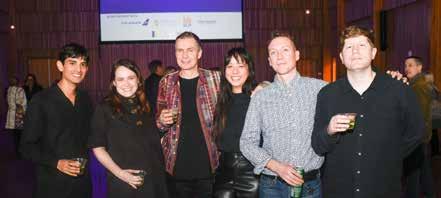
icelandair.com
For over a decade, Icelandair has remained the fastest way to the Nordics, connecting the Pacific Northwest to the heart of Scandinavia through the Spirit of Iceland from Seattle, Portland and Vancouver. Towering glaciers, rocky lava fields and mesmerizing auroras are included when you Stopover in Iceland for up to 7 days at no additional airfare.
Book your Nordic adventure now.

 Programs
Programs
IN THE SUMMER OF 2012, ICELANDIC SCULPTOR STEINUNN THÓRARINSDÓTTIR DEBUTED A PUBLIC INSTALLATION TITLED BORDERS AT WESTLAKE PARK IN DOWNTOWN SEATTLE. To complement this installation, an exhibition of small edition works was displayed at the National Nordic Museum’s former location. Over a decade later, Steinunn will return to the city for a large-scale installation at the new site of the Museum. The exhibition Wayfinders will greet visitors upon their arrival and guide their path throughout the public spaces of the Museum. Wayfinders will consider life’s journey, including travels and resettlement abroad generally, and the Nordic-American experience specifically. Both aesthetically and conceptually,
it was designed for the Museum. I had the opportunity to ask Steinunn about her career and her vision for Wayfinders.
LA: Leslie Anne Anderson, Director of Collections, Exhibitions, and Programs, National Nordic Museum
ST: Steinunn Thórarinsdóttir, Artist
LA: How did your studies in England and Italy shape your artistic development? How has Iceland informed your vision?
ST: I consider myself lucky to have studied sculpture in England in the 70’s as the scene was incredibly strong in 20th-century and contemporary sculpture. I was also lucky to have tutors that were active, working sculptors, most of them living in London. Right from the beginning, I was doing figurative work, something that wasn’t necessarily being done at the time, but they gave me such great encouragement. During my BA studies I was in the Ceramic Sculpture Department and clay has always been a big part of my process, especially in the first years. I was also in the Sculpture Department—a lot which was right next door, so we could work in both places which was great.
Going from England to Italy shaped my visual world even more precisely. When I moved there, I realized just by looking out the window that I was living in a museum. That museum was there to explore. It was truly profound, for example, going to Pompeii and experiencing those frozen moments in time through the shapes of figures was special and an eye-opener. My own figurative sculpture was influenced by those earthy and organic pieces. The Pompeii figures were not meant to be sculptures, but they are very sculptural. In addition, there is the tragic narrative that they give away, but still they do not tell you the whole story. The frozen moment before something happens or just after something has happened has been a part of my own figural world ever since.
Living and studying in these two countries helped me form and understand the combination of the classical and contemporary in my work. It’s a phrase I use a lot, but in many ways, it’s an accurate description.
Being born in Iceland with its rugged terrain and organic texture is of course very much part of my work, as well. Initially, while studying in England, one of my favorite tutors, Darrell Vyner, who sadly passed away rather young, encouraged me to be true to myself and my origin because that was what made my work different. The atmosphere and spirit of my work is strongly connected to Iceland and the solitary character of the landscape and its vast spaces. Iceland is a huge country when you compare it to the size of the population. My BA thesis in the UK was titled “The Hidden People” and it reflected upon how my own figural work was influenced by the idea of that specific myth in Iceland. The Icelandic myth describes people who live in cliffs and stones, and they lived an otherworldly existence but sometimes would visit “our” world. In my mind, that was such a great reference to what I was doing even though it wasn’t as such a literal reference but rather a philosophical and symbolic one. It also helped me to shape and define my figures and devel-
op them into the androgynous, organic, and in many ways, alien beings that they are. Being born in Iceland makes you realize the enormity of nature, but at the same time, that you as a human being are part of nature. We sometimes forget about that when we speak of artists who work with nature and landscape. I find it strange that figurative artists are often not entered into that equation.
LA: Why did you choose sculpture as your preferred medium? What role does watercolor play in your work?
ST: I did my foundation course in England, and then tried all forms of art. One of those forms was sculpture, and as soon as I started working in three dimensions, it just felt like coming home. A strange feeling but reassuring in the sense that I knew I was in the right place. It was not a given, especially as at the time I started, sculpture was then more of a man’s world in the arts. I never really thought about it that way, but it felt totally natural to me.
The watercolors have a strange role in a way as they are my relief from sculpture. The process of sculpture is long, complex, and time-consuming, but doing these sketches is very direct and different. I create them in my small country studio, which is on the south coast of Iceland, situated under the infamous volcano Eyjafjallajökull that stopped all air traffic in Europe. It was very unpopular at that time! The studio has windows to all directions, and in it, one feels like part of the landscape. Looking to the south there is an endless horizon, and looking to the north there is the incredible beauty of the Eyjafjallajökull mountains. I call them watercolor sketches, as they are made quite quickly, and I do not dwell on them. I use the brush like a pencil and never draw them first. They are very spontaneous, and I have no preconceptions of what they will look like. I like to approach the paper like a child and enjoy working on them like a child. The sketches reflect my surroundings in the country house, and there a strong feature is the horizon line that has this
feeling of endless space and promise. Man and nature together as a team. The sketches are closely connected to my sculptures and how they find their place in nature as solitary beings. They are not just about the romantic idea of man and nature, but also, they speak about how we as human beings share the stage with others and with the environment.
LA: Which artists, past or present, do you admire?
ST: I admire many artists but initially when I started to work in sculpture, the Icelandic pioneer sculptor Einar Jónsson influenced me. He was figural but at the same time other-worldly and dramatic. Very Icelandic in a way and so special. I love showing visitors to Iceland his museum which is in the building that he designed himself and lived and worked in. His home is shown relatively untouched within the museum and it’s all just very eccentric and beautiful.
LA: Using a work or an installation as an example, please describe your artistic process from inspiration to realization.
ST: The artistic process actually varies quite a lot depending on how specific the concept is. Sometimes I make work almost just by intuition, and I do not know precisely why I made them. Increasingly, I don’t work the ideas on paper first. I just have them in my head and start the process. If the concept is very specific, there is more planning. Normally, that means there is a specific space or venue that I’m working with. I have made many site-specific works, both for private collectors, exhibitions and public works.
A good example to describe that process is an installation called Horizons that I made specially for the Katonah Museum Sculpture Garden in Katonah, New York. The sculpture garden is round and enclosed by a concrete wall. It has ten huge Norwegian Spruce trees planted within that wall and one tree in front of the museum. The trees give the space an incredibly special character.
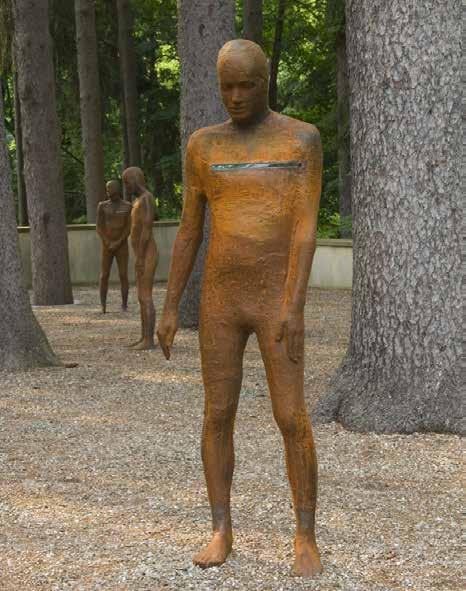
So, it was a natural choice for me to make ten cast iron figures that would be placed among the trees and one figure in the front by that single spruce tree. The figures themselves are very organic with a similar texture as the trees, and I put small branches from the trees on the surface of the plaster originals so that they are embedded in the memory and surface of the figural sculptures. The figures are in a way trees themselves and they lean in different directions like trees sway in the wind. As you walked among them, one disappeared and another one appeared. Within each figure there is a piece of glass that goes through them in the chest area. The glass is positioned horizontally at the same height in each figure. So, the horizontal line unites all the figures together. The day-
light and sun shines through the glass at different angles so the work changes throughout the day. The open daylight line also references the horizon both in the landscape, but also within us. The fact that the garden was enclosed inspired me to open up the figures.
I make the originals in plaster, so I can add and subtract material. When the original is finished, it goes to my foundry to be cast in metal. All my pieces are made from recycled material. The foundry makes a sand mold in many parts, and they make a core as well so that when the figures are cast, they are not solid but have a cavity. Once the sand mold is ready, the metal is heated to a liquid and poured into the mold. The liquid metal is very hot and has the color of magma, volcanic molten lava.
Horizons, in the Katonah Museum Sculpture Garden. Cast iron and glass.Being an Icelander, I have always found that to be quite symbolic. Once the metal has been poured into the mold, it cools off and then the mold is broken and opened so it’s like a birth.
LA: Tell us about Wayfinders. How did you develop the concept?
ST: I had some years before I developed a concept for Borders, an installation that was first staged in Dag Hammarskjöld Plaza by the United Nations Headquarters in New York City in 2011. Its core idea is about crossing borders and connecting people over borders. That came to mind when thinking about making an installation for the Museum. All those individuals from the Nordic countries who came to the U.S. to seek a better life for themselves had to cross borders. While working on the idea, I thought about my uncle Friðrik Sigurðsson, my grandfather’s brother, who left his childhood home in one of the most remote farms in east Iceland and went to America. Friðrik changed his name to Fred and became a barber in Brooklyn and lived there all his life, never returning to his native country.
Very soon in the development of the concept, I formed the idea to make a
weave of figures that would be placed in strategic areas outside and inside the Museum. The visitor could get a sense of human connectivity throughout the building and its surroundings. The museum building became an open border so to speak. There is a feeling of movement from place to place referencing an immigration of sorts, a new beginning, an alien but exciting experience. This weave of connected human figures references the influx of Scandinavians that came to America to fulfill a dream.
The sculptures are all made of cast aluminum that harmonizes with the building’s colors and materials. The aluminum is a strong visual thread in the weave. The shiny aluminum reminds us of the crisp Nordic skies and the seas connecting country to country. The material also has a brave shine that will feature as rays of light throughout the public areas of the Museum inside and outside. The figures are all different but there is a sense of familiarity from one figure to the next. They are symbols of humanity and represent the general human psyche rather than a specific gender or ethnic identity. The emphasis is on the fact that we are all connected as humans despite our differences.
I had seen photos of the beautiful museum building, but when visiting it last year in preparation for the show, the human weave came together and the figures found their rightful place inside and outside, some in unexpected places. They are in the Fjord Hall, they lie/swim on the Fjord Hall walls, cross bridges (borders) and in general interact with the various spaces and in some instances, there is a merger of the contemporary figures with the Museum’s permanent collection of historic artifacts bringing in an almost surreal interplay.
LA: Your sculptures are anonymous, androgynous human-sized figures, approximating the size (and even the weight) of the body. How closely should the viewer identify with these works?
ST: The sculptures are, despite their seeming anonymity, based on my two sons. My older son has been the model for most of the work, but in the last few years, I have started to torture my younger son as well! I say torture because being the model is very hard, but they have still been kind enough to do it for their mother. Thórarinn Ingi, the older, has said that in hundreds of

years when people find relics of these pieces, they will think that he was a god! However, they are just the base for the work and the final figures may not necessarily look like them because I change them quite a lot. Still, doing it this way has worked well as the pieces become close to me and are family. Despite this, they are anonymous and androgynous, and the viewer should be able to identify with them regardless of their gender or ethnic identity. Also, the figures tend to be neutral in their postures and appearance so people feel that they can approach them. I prefer the figures to whisper rather than shout. It leaves the work more open to interpretation and doesn’t dictate what people should see in them. The viewers are all different and they will find their own meaning.
LA: Do you intend for the viewer to interact with your sculptures?
ST: Interaction is very important, and I love to see people do that with my sculptures, but I prefer it to be interaction with care and respect, just like you would want to be treated yourself. Again, because they are neutral, people do approach them and interact with them in all sorts of ways. The good thing about that is that the viewer becomes part of the work, makes it whole so to speak. It could be argued that the work is not complete until the viewer comes into the picture. However, it has happened that people become too familiar with them and in some cases to the extent that they have stolen works. A little bit too much interaction!
LA: The environment–in this case, the built environment of the Museum's exterior and interior–is in dialogue with your sculptures. Are you looking for a specific context of display when you collaborate with a museum?
ST: If I’m working with specific buildings or spaces, they certainly become a big part of the conceptual development of the installation. One could imagine that working for a specific site or space would be confining and too practical, but I find that it opens windows to new

ideas and new approaches. For example, the Museum building inspired me a lot and dictated the placements of the pieces. The building itself made the works find their way in it. They became Wayfinders, for the human weave, both referencing the Scandinavian immigrants to the United States but also referencing all of us who are finding our way to navigate the world.
Steinnun Thórarinsdóttir: Wayfinders will be open from July 15–November 5, 2023.

The exhibition has been made possible in part by Icelandair.
Watercolor, Cord Series, 2021
 IMAGES FEATURED: The artist's watercolor studio view
IMAGES FEATURED: The artist's watercolor studio view
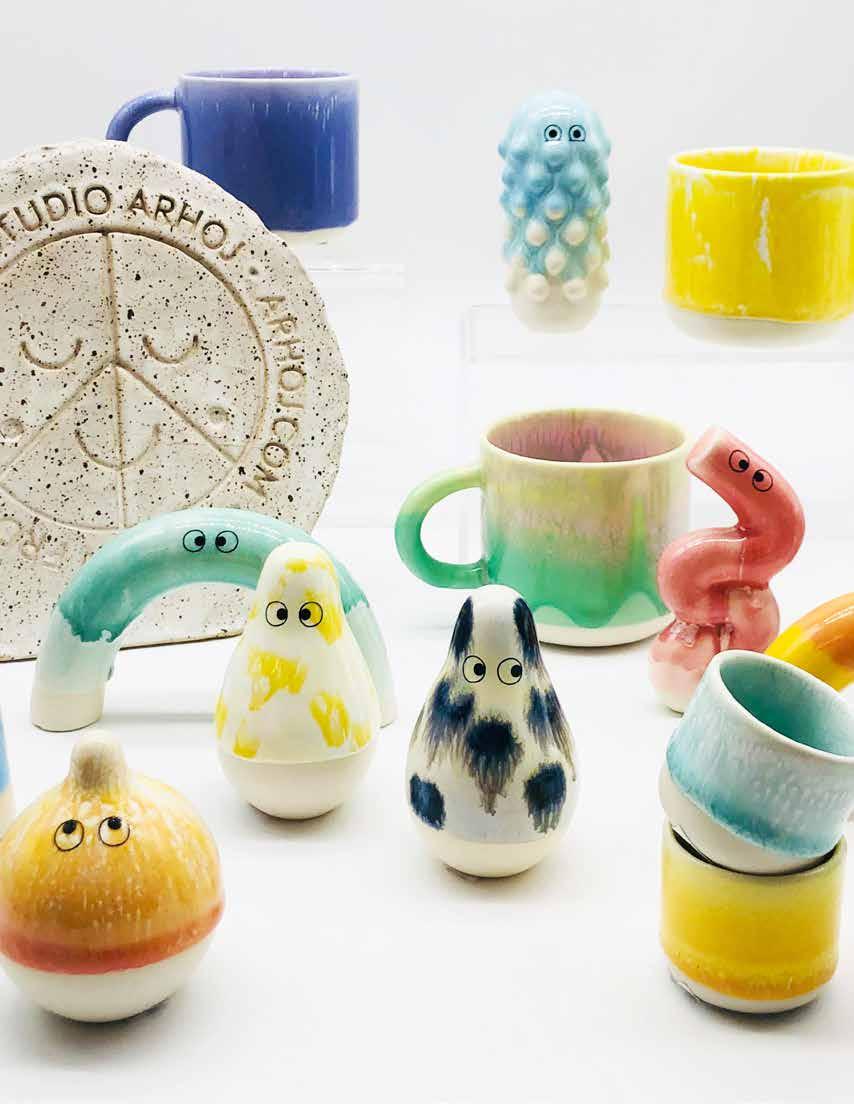
I WENT TO COPENHAGEN FOR THE FIRST TIME
ON A WHIM. My year-long sabbatical, a perk of being a tenured professor, was coming to an end and I wanted to do something exciting. I decided to spend the months of May and June 2010 abroad and selected Denmark because I was watching a lot of Danish films. I did not know anyone in the entire country, and I had never been. I fell in love with Copenhagen and returned repeatedly during many winter breaks and every summer since 2010, including a year as a Fulbright scholar, for a total of sixteen times. During the summer of 2013, I lived in the Nørrebro section of Copenhagen. I frequently took a shortcut through the Assistens Kirkegaard cemetery to the cafes on the trendy street Jægersborggade. Famous Danes such as The Little Mermaid author Hans Christian Andersen and philosopher Søren Kierkegaard are buried there. I noticed on the path back to my apartment a rather prominent headstone with the very non-Danish name of Ben Webster. I was surprised to discover that he was one of many African American jazz musicians who lived and were buried in Copenhagen. The graves of pianist Kenny Drew and trombonist Richard Boone are behind Webster in a special jazz section. Thad Jones, trumpet player and leader of a legendary Village Vanguard band, and drummer Ed Thigpen are buried side by side in another cemetery along with pianist Duke Jordan interred in a different section. That cemetery, Vestre Kirkegaard, is down the street from the prison where African American trumpet player and bandleader Valaida Snow claimed she was detained for two years during WWII by the Nazis during their occupation of Denmark. I had never heard about African Americans living in Denmark and was curious. I wanted to know why did they go to Denmark? What were their experiences while there? During my initial exploration I found two things that surprised me: the considerable number of African Americans, famous and unknown, who had significant experiences in Denmark, and the overwhelmingly positive nature of their journeys.
I discovered that African Americans, like Booker T. Washington, viewed Denmark as a utopia. Washington called it the happiest country in the world after his visit in 1910, long before it regularly topped the happiest country lists in the 21st century. In the beginning of the 20th century educators, civil rights activists, scholars, social workers, and union organizers went to Denmark to study the adult folk schools and cooperative movements for farmers. They hoped to
create similar programs to help African American sharecroppers, tenant farmers, and members of the Great Migration. Although their primary reason for going to Denmark was to uplift the race, many also had a secondary motive—a sense of adventure and a respite from U.S. racism and segregation. In the second half of the century, African Americans went to Denmark for more individual reasons and began permanently living there. Artists and performers like jazz saxophonist Dexter Gordon and singer Ella Fitzgerald found financial and creative support for their work in Denmark. They also found romance. Many married Danes and started families— often second families for the frequently middle-aged jazz musicians or artist like Walter Williams. The writers, artists, and musicians also felt that the lack of racial discrimination created an atmosphere in Denmark that increased their productivity.
“Paris was a cliché,” said Pulitzer Prize winning poet Gregory Pardlo in his 2018 book, Air Traffic: A Memoir of Ambition and Manhood in America, when he explained his decision to go to Copenhagen. He said, “Copenhagen was my calling, and a hipper Promised Land than Paris for black intellectuals escaping the stifling air pollution of American racism.” My research expands the geographic boundaries of the ofttold tale of African Americans abroad. There are numerous books about African American expatriates in Paris including Langston Hughes, James Baldwin, Josephine Baker, and Richard Wright, to name just a few.
During the last several years, I used both American and Danish primary and secondary sources to research African American lives in Denmark. I also searched archives in the United States and in Denmark. I read historical African American newspapers (for example, Amsterdam News and the Chicago Defender) and Danish newspapers (including Politiken and Berlingeske Tidende) containing articles by and about African Americans in Denmark. I read articles in African American journals including the NAACP’s Crisis, Ebony, and Jet. I scoured scrapbooks, personal and professional correspondence, photographs, postcards, programs of cultural events, travel columns and essays, jazz records, paintings and prints, declassified FBI files detailing the activities of Black Panthers in Copenhagen and the Black Panther’s newsletter. I explored biographies, autobiographies, and memoirs. I interviewed the widows, children, and friends of the subjects in my book. I also interviewed the
IMAGES FEATURED: International People’s College in Helsingnør, 1930, (top two images)

Summer 2022 African American Expatriates in Denmark class at Frederiksborg Castle, (lower

 left)
left)
In 2021, Dr. Ethelene Whitmire and I set to work on transforming her research on visual and performing artists and scholars in the Nordic countries into a museum exhibition. This important story would be told through objects, many of which belong to collections in the Nordic countries and the United States. Our exhibition checklist developed rapidly and included paintings, prints, sculptures, documentary and feature films, music, personal letters, newspaper articles, and photographs.
In June 2022, I traveled to Sweden for research and met with potential participants. Among the curatorial colleagues I spoke with were the staff at the Moderna Museet in Stockholm. Moderna Museet has generously agreed to lend four works of art, including William Henry Johnson’s Girl in a Red Dress (ca. 1936). We also secured stunning loans, such as Herbert Gentry’s Mask (1959), from private collections. Ethelene and I even scoured eBay for potential additions to our checklist. From an online seller, the National Nordic Museum purchased two objects for its permanent collection, including the April 1970 issue of Ebony magazine featuring an article titled “Thanks to Doug Crutchfield Fru Nilsen Can Dance Again,” about the dancer (1938 – 1989) who was born in Cincinnati and later resided in Copenhagen, and the stretched textile Blue Irises (1978) designed by Howard Smith (1928 – 2021) for the Finnish firm Vallila. From a variety of sources, we are assembling objects that illuminate the untold story of African American creatives and intellectuals who sought inspiration and opportunity in the Nordics.

artist Ronald Burns, who has resided in Copenhagen since 1965 and knew many of the people in my book.

I began teaching study abroad courses in Denmark in 2018, bringing American students, primarily Black American women, to Copenhagen to learn about the African American experience in this nation. I followed in the footsteps of the African Americans to see the prison in Horsens where Marian Anderson sang to enthralled prisoners in the 1930s. It is now a world heritage museum and hotel. I declined to spend the night in their prison cell/hotel—although my students did in summer 2019 while following Anderson’s footsteps for my study abroad course. My class toured the museum in 2022, and we ate stegt flæsk for lunch afterwards at Dollys to sample the Danish national dish. Each class also samples a lunch of smørrebrød, the famous Danish open-faced sandwiches.
In 2021, we stayed in Hindsgavl Slot, a castle in Middlefart, also now a hotel, where Julliard-trained classical pianist Eugene Haynes played by candlelight for a chamber music festival in the 1950s. We also toured Karen Blixen’s house and museum in Rungsted Kyst where she entertained Haynes who befriended her in the 1950s. In 2021, I took my class to the Johannes Larsen Museeet in Kerteminde where painter William Henry Johnson lived in the 1930s and saw the windmill he painted, the landscape, and the beach where he captured the fishermen in his paintings. All were featured in an exhibition at the museum.
I watched the Danish film, Oh Happy Day, with an African American lead character and contacted the actor, Malik Yoba, about his experiences working in Denmark. Yoba said, “I absolutely loved living and working in Denmark for a few months. It was one of the highlights of my career being able to be immersed in the Danish culture.” I read the three novels with African American protagonists in Copenhagen including the historical novel Valaida by Candace Allen about Valaida Snow. I read the Harlem Renaissance novel, Quicksand, by Nella Larsen. The main character Helga Crane was half Danish and half Black like Larsen. I also read Cecil Brown’s controversial The Lives and Loves of Mr. Jiveass N____, a satirical cult classic novel among highly educated African American men. I watched numerous documentaries about expatriate jazz musicians in Denmark including one by a Danish filmmaker, Cool Cats, about Ben Webster and Dexter Gordon in Copenhagen. I saw performances in the still-existing jazz venues La Fontaine and Jazzhaus Montmarte. I placed flowers on the graves of numerous African American expatriates including journalist and Black Panther co-representative in Denmark Leonard “Skip” Malone. I dined with his widow and met one of his daughters for coffee. His grandson, Alexander Malone, is the bassist for the popular Danish band Scarlet Pleasure. I searched the archives and attended the morning session of the International People’s College in Helsingnør/ Elsinore. During the 1930s many African Americans were students and speakers at that institution. I took a class to visit the still-existing institution after a visit to Kronborg Castle, the setting of Shakespeare’s Hamlet. I saw the
“Thanks to Doug Crutchfield Fru Nilsen Can Dance Again,” Ebony (April 1970). National Nordic

former Charlottenlund Palace where Booker T. Washington dined with the King and Queen of Denmark in 1910. It is close to the apartment building on the nicknamed Danish Riviera where Ella Fitzgerald planned to make her home in the early 1960s in Klampenborg. In June 2018, I sailed across the Atlantic Ocean on Cunard’s Queen Mary 2 to replicate the journey of the African Americans in the first half of the 20th century who recorded their voyages in a newspaper column and in memoirs.
My proposed book, Searching for Utopia, weaves together the captivating stories of African Americans in Denmark during the twentieth century to create a rich portrait of their experiences in Denmark. In 2024, the National Nordic Museum plans an exhibition, African Americans in the Nordics. The exhibition will capture these stories and more including adventures of African Americans in other Nordic countries such as the artist Howard Smith who lived in Finland for nearly fifty years, or singer Anne Brown, Bess in Porgy and Bess, who married 1948 Norwegian Olympic skier Thorleif Schjelderup and raised a family in Oslo, Norway, until her death in 2009.
The exhibition will feature the wonderful art of Walter Williams, inspired by his visit to the Danish island of Bornholm to create imaginary landscapes filled with children, butterflies, birds, and sunflowers to capture the hope of a new day for African Americans.
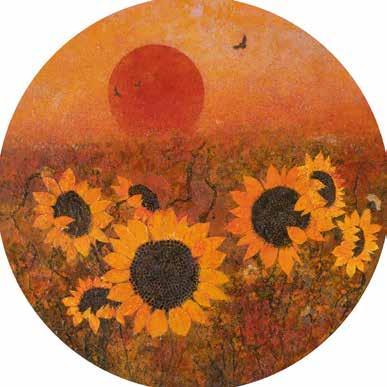
African Americans in the Nordics will be open from March 23–July 21, 2024.

 Walter Williams, Sunflowers, 1975-1976, medium oil and sand on masonite. The Johnson Collection, Spartanburg, South Carolina.
Walter Williams, Sunflowers, 1975-1976, medium oil and sand on masonite. The Johnson Collection, Spartanburg, South Carolina.
THE EARLY 20TH CENTURY has been called the Heroic Age of polar exploration, a time when explorers sought the ends of the Earth by ship, dog team, aircraft and foot.
What’s little remembered now is the role Seattle and the Pacific Northwest played in the polar probing that dramatically changed our understanding of the planet. Clues about that legacy of polar exploration are found in artifacts left by one man in particular—an unparalleled explorer—who sought aid, rest and repair, money, and moral support here.
Today, climate change is opening Arctic waters as ice melts. But it wasn’t always so. Finding a water route through the far north was long a goal for explorers and colonizers.
Explorers like Captain James Cook of Britain came to the Northwest seeking the legendary Northwest Passage—a northern sea route rumored to link the Atlantic and Pacific. Empires hungered for the trade such a passage could
bring. Their emissaries sailed until they were stymied—and sometimes crushed—by the ice.
The loss of an expedition led by the British Navy’s Sir John Franklin, who was seeking the Northwest Passage, spurred more exploration. Franklin and his crew entered a forbidding, icy realm in 1845—and then vanished. Search parties for his ships and crew were unsuccessful, but they extended geographic knowledge. Franklin’s quest and fate inspired a 15-year-old Norwegian boy to find answers. His name: Roald Amundsen.
In the late 1800s and early 1900s, Amundsen was part of a new generation of explorers determined to conquer the ice. He dreamed of traversing the Northwest Passage by ship. And eventually he found a way. Norway wanted to assert its rights to northern lands and shape a new national identity. These ambitions fueled Amundsen’s drive.
From 1903 to 1906, Amundsen led an expedition by boat—a converted herring boat called the Gjoa— from Greenland through northern Canada to Alaska. It took patience; this small craft was locked in ice as it inched its way across. When the Gjoa emerged after two winters in ice, Amundsen became the first to have navigated the passage.

Amundsen arrived triumphant in Seattle where he was feted by the large Scandinavian community. The Seattle Times compared his achievement to those of Franklin and Sir Francis Drake.
That success stoked Amundsen’s ambitions. He headed south and became the first to reach the South Pole in 1911, attaining global celebrity. He then headed north again, this time in a vessel, the Maud, built to withstand the ice. He hoped the ice floes would take the ship to the North Pole, but instead he successfully navigated the Northeast Passage across Siberia, only the third person to have done so.
The Maud became a kind of multiyear floating laboratory, taking scientific readings. At one point the ship came to Seattle for repairs and refitting after its propellers were damaged by the ice. Amundsen stayed in Seattle six months. He met a local Danish American businessman, Haakon Hammer, who became his business manager. Amundsen was a spender and had to raise vast sums for his expeditions.
When the Maud went back north to Alaska in 1922, Seattle gave Amundsen’s crew a hero’s sendoff from a dock near
what is now the Olympic Sculpture Park. Amundsen had used his time in Seattle to outfit for a new era of Arctic exploration with modern technology. On board the Maud were two new airplanes in crates. Amundsen intended to pioneer the Arctic from the air. He wanted to fly from Alaska to Spitsbergen in Norway.
The planes—a Curtiss and a Junkers—had neither the range nor strength to survive the rigors of Arctic exploration, so Amundsen raised funds and later returned with bigger, better airplanes to try another transpolar flight, but that expedition had to be abandoned after he crash-landed on the ice. Meanwhile, Hammer’s business management had driven Amundsen into bankruptcy.
Undeterred, Amundsen sought to fly north via even newer technology. He teamed with the Italian airship inventor Umberto Nobile to fly to the North Pole in a dirigible with a Norwegian crew, American financing from explorer Lincoln Ellsworth, and a team of Italian
mechanics. In 1926, the airship left Spitsbergen and in just 17 hours traversed the pole.
By that time, explorers Robert Peary and Frederick Cook had already claimed to reach the pole on foot, and another, Richard Byrd, had claimed to fly over it. Yet serious questions have been raised about the accuracy of those accounts and their calculations, and it now appears that Amundsen and company weren’t just the first to float an airship over the North Pole, but in fact the first on record to have actually reached it.
The Norge fell short of its intended destination of Nome and had a hard landing in Teller, Alaska. Still, it was a 20th-century triumph. When they returned to civilization—aka Seattle— they were given a huge welcome. But the rather dour Amundsen took offense at Nobile and his crew, in part because he thought they were trying to hog the glory, but also because Amundsen was against fascism and Nobile’s success was embraced by Mussolini.
Some years later, Nobile would try his own Arctic expedition in another airship, but it crashed. Amundsen set out by plane to search for Nobile and his lost airmen. Nobile was rescued, but Amundsen’s search plane disappeared in the far north and, like his hero Franklin, he was never found.
But relics, including a pair of snowshoes at the National Nordic Museum in Ballard, help us remember that our region had a role in the adventures of polar exploration’s greatest hero.
For more on this story, listen to the Mossback podcast, or watch the Mossback's Northwest (KCTS9) episode "Amundsen's Snowshoes," filmed at the National Nordic Museum. This article is reprinted with permission from Crosscut.
Art Walks – 2nd Sat each month, year-round, 5-8 pm
Poulsbo Historical Museums – Daily, Call for hours
SPRING
Girls Night Out – 1st Wed in May
St. Paddy’s Beer Run –Sat before St. Patrick's Day
Syttende Mai (17th of May)
Festivities – Mid-May, SON
Viking Fest – 3rd weekend in May
SUMMER
Midsommer – 3rd Sat in June, SON/Waterfront Park
Concerts by the Bay – Every Tues, July & Aug, 6:30 pm
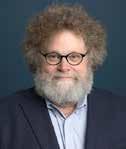
Poulsbo Arts Festival –3rd weekend in Aug

FALL
Poulsbo Beer Run – Oct Downtown Safe Trick or Treat – Oct 31st, 4-6 pm
WINTER
Shop Small Saturday –Sat a er Thanksgiving
Free Visits with our Nordic Santa – Sat & Sun
Thanksgiving-Christmas
Julefest, Nordic Market & Bonfire – 1st Sat in Dec, SON
Lighted Ships Parade – 2nd Sat in Dec, 5:15 pm, Waterfront Lutefisk & Meatball Dinner –last Sat in Jan, SON


historicdowntownpoulsbo.com
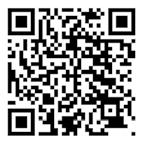

 By Dr. Lotta Gavel Adams
Isak Heartstone (Breckenridge 2018)
By Dr. Lotta Gavel Adams
Isak Heartstone (Breckenridge 2018)
THE FIRST THOMAS DAMBO troll on the North American continent, stuck his toes into the waters of the Caribbean Sea on the island of Culebra, Puerto Rico, in 2014. It was Hector, the Protector, made of recycled scrap wood. He held a big stone in his hand, ready to protect the island from invaders and damaging hurricanes. And he did. When Hurricane Maria hit in 2017, Hector took the brunt of the winds and waves, and was knocked out. But no lives were lost on the island, for which the islanders credited Hector. In 2019, the islanders invited Thomas back to recreate their beloved Hector. The new Hector holds a lantern in his raised hand, warning approaching hurricanes, that here lies Culebra and you must go around.
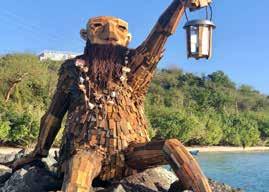
Thomas Dambo, Danish rapper, storyteller extraordinaire, skilled carpenter by trade, wood sculpture artist and recycle activist, is conquering the world with his cute and whimsical giant trolls telling the humans, the little people, to stop polluting the planet. Thomas comes from a strong storytelling tradition. He was born in Odense in 1979, the same city as Hans Christian Andersen 174 years earlier. The storytelling tradition from Odense is alive and well.

Since Hector, the Protector, twenty-four more Dambo trolls have popped up in the US–in addition to his troll installations in China, South Korea, Chile, Australia, and of course Denmark. The latest ones are Bo, Bodil, and little Bibbi in Aullwood Audubon, Ohio, Mama Mimmi in Jackson Hole, and the five troll Guardians of the Seeds in Coastal Maine Botanical Gardens. People are flocking to see them. His Isak Heartstone in Breckenridge, Colorado, caused such a stir, attracting more than 3,000 visitors on certain days, that he had to be moved to a more accommodating place. Rocky Bardur and his five fellow trolls, in the Morton Arboretum in Chicago, got tired of the little humans continuing to pollute and destroy their beloved nature so they decided to hunt them down and teach them a lesson. Look out for Rocky and his big stone!

Trolls run deep in Nordic folklore and imagination. Since olden times,
they have lived deep in the forests and mountains of the Nordic countries. The trolls were feared because they owned nature. The natural resources were theirs and they were rich. They looked imposing and dangerous like Theodor Kittelsen’s Forest Troll from 1906. The message was clear: Trolls and nature are big, powerful, and scary. You, the

for us, the little people, is: What have you done to the planet in the last one hundred years when you thought that you were the masters of the universe? Look at all the trash you left behind and look at the pollution you have created, and all the trees that you have cut down. It is time for you to reexamine your lifestyle.
There may still be hope for the Pacific Northwest. We understand that seven Dambo trolls have applied for visas to come to the Pacific Northwest. Now they are looking for comfy little forest spots, preferably close by the waters of the Salish Sea so they can communicate with the Orcas.
human beings, are small and insignificant, and scared. You better behave when you are in the forest. Things changed after the arrival of industrialization in the Nordic countries at the turn of the last century.
Humans were getting more confident and cockier, gradually imagining themselves to be the center of the universe. Trolls were safely relegated to legends and tales of superstition. Then, trolls started migrating into children’s books, where they stayed for the entire 20th century. They became a useful teaching tool for elementary school teachers, telling their young students that they needed to be strong and enterprising in the new world: Just look at those trolls! They are big and dumb, and easy to cheat. You, young boys and girls, are stronger and smarter. It is time for human beings to take charge of the world. But that did not turn out too well.
In the last couple of decades, the trolls have been returning in films and books for grown-ups. And they have a message for us. Through their many distorted forms, the trolls hold up a mirror to us, the human beings, and ask us what we see. What have you done during your hundred years in power? Enter the Dambo trolls. Their question
IMAGES FEATURED: Theodor Kittelsen’s Forest Troll from 1906, Nasjonalmuseet, Oslo, Hector the Protector, 2nd version (Puerto Rico, 2019), Artist Thomas Dambo, Author Lotta with Thomas Dambo's Nordic Swan at the National Nordic Museum.
At least travel to the National Nordic Museum. From the Nordic countries, heads of state, royalty, and ambassadors all came to events throughout the year. We also welcomed Senator Patty Murray, Gov. Jay Inslee of Washington, Seattle’s Mayor Bruce Harrell, community leaders, policymakers, and artists throughout the year.
For our Members and other guests, this led to such unprecedented programing such as hearing first hand from Sweden’s Prince Daniel about his initiative to connect young Nordic entrepreneurs with United States companies, the President of Iceland about his visits to American tech firms to advocate for adding Icelandic and other languages to AI devices, the Finnish Ambassador about the country’s move into NATO, the First Lady of Iceland’s about her book on how to achieve gender equity globally based on the Icelandic model, from the Danish Ambassador about her country’s commitment to sustainability, and many more.
Then 2023 began with the President of Finland's historic visit to the Museum (more on page 30).


Jay Inslee, WA Governor, Eric Nelson, Executive Director/CEO, HRH Prince Daniel of Sweden

Eric Nelson, Executive Director/CEO, Anniken
Krutnes, Ambassador of Norway to the U.S., Kjetil Krutnes at Ballard’s Syttende Mai Day parade
Eric Nelson, Executive Director/CEO, Sauli Niinistö, President of Finland, Mikko Hautala, Ambassador of Finland to the U.S., Marko Liias, Washington State Senator at the Museum
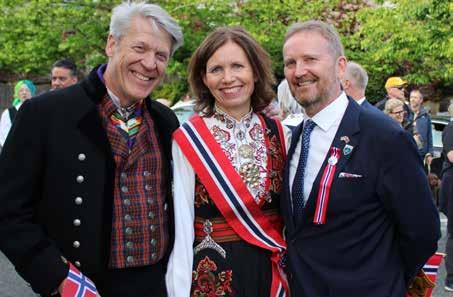
IMAGES FEATURED:
1. (from left to right) Bruce Harrell, Mayor of Seattle, Eric Nelson, Executive Director/CEO, Dan Strauss, Seattle City Councilmember

2. Lone Dencker Wisborg, Ambassador of Denmark and Eric Nelson, Executive Director/CEO in front of Thomas Dambo’s Swan
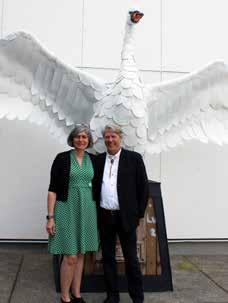
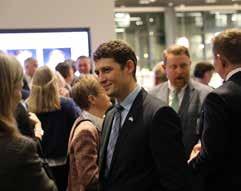
3. (from left to right) Jeanne KohlWells, King County Councilmember; Patty Murray, U.S. Senator; Noel Frame, WA State Senator

4. Gov. Jay Inslee in the From Dawn to Dusk exhibition at the Museum

5. Mikko Hautala, Ambassador of Finland to the U.S. and Finnish photographer Janne Tuunanen at Aalto exhibition opening.


6. Eliza Reid, First Lady of Iceland

7. Guðni Th. Jóhannesson, President of Iceland
8. Valeriy Goloborodko, Honorary Consul of Ukraine
Photos by Carly Hinman and Museum staff

 by Terje Leiren
by Terje Leiren
ums with important Viking collections are included in the itinerary.
The National Nordic Museum’s Executive Director/CEO Eric Nelson and Professor Terje Leiren will lead a two-week exclusive tour of major Viking sites in Iceland, Sweden, Denmark, and Norway in 2023.
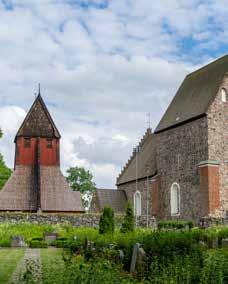








By the time the magazine went to print the tour had sold out. To join the waitlist or for more information visit nordicmuseum.org/vikingtrip or scan the QR code.


ON SEPTEMBER 27, 2022, the National Nordic Museum’s Executive Director/CEO Eric Nelson was inducted into the Scandinavian-American Hall of Fame. The Hall of Fame recognizes notable persons of Nordic descent who have achieved greatness in their fields of endeavor. Established in 1984, this honor and its Awards Banquet is the hallmark event of the Norsk Høstfest held in Minot, North Dakota. Previous honorees include astronaut Buzz Aldrin, U.S. Vice President Walter Mondale, Seattle fishing captain Sig Hansen (“Deadliest Catch”), Nordic Ware founders Dorothy and David Dahlquist, and more.
I’m honored to receive this award and to support the work of the National Nordic Museum in preserving and promoting Nordic culture,” said Nelson. “This award also celebrates the close ties between the United States and Scandinavia, as does the Museum.”

Eric Nelson joined the National Nordic Museum as Executive Director/CEO in January 2008, where he has overseen the expansion of the Museum into a nationally and internationally recognized center for sharing Nordic culture, values, and innovation. He has been honored with the rarely awarded Hazelius Medal in Gold, the only non-Swedish citizen to receive the recognition, as well as having been named the Knight of the Order of the White Rose of Finland by the President of Finland Sauli Niinistö and awarded Knight 1st Class of the Royal Order of the Polar Star by His Majesty King Carl XVI Gustaf of Sweden.
Under Nelson's leadership, the Museum earned international recognition. Nelson led the successful $53 million campaign to build the award-winning iconic building that now houses the Museum’s 80,000-object collection. The Museum received an outpouring of public acclaim upon the opening of its new building in May 2018; the following year the Museum received its national designation by an Act of Congress.
The Museum presents more than 140 programs annually including contemporary art exhibitions, concerts, lectures, films, and educational events.
Nelson is a graduate of the prestigious Getty Museum Leadership Institute and holds a Master of Art degree in History. He has served as a guest lecturer at the University of Washington, California State University, and Sacramento and San Francisco State University. A native of Napa, California, Nelson was Executive Director of the Napa Valley Museum from 1999 to 2007. Prior to this role, he was Curator of Exhibits and Collections and then Executive Director of the Sonoma County Museum in Santa Rosa for eleven years.
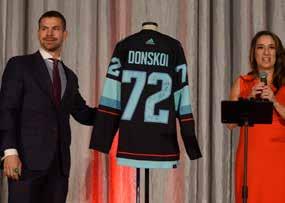
Held at the Hyatt Regency Seattle, the Northern Lights Auktion organizers and attendees celebrated its 37th year as the Museum’s most important fundraiser in April. Under the able leadership of the Auktion co-chairs Elisabeth Bodal, Krystn Nesselquist, and Sofia Taylor, the Auktion Committee produced a memorable evening for more than 400 guests while generating record-breaking support for the Museum’s programs, exhibitions, and operations.
Among the highlights of the event was a moving tribute to Irma Goertzen, who served as President of the National Nordic Museum Board of Trustees from 2010 to 2019. On the night of the Auktion, Goertzen was awarded the Allan Osberg Award for Distinguished Service.

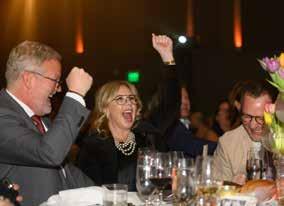
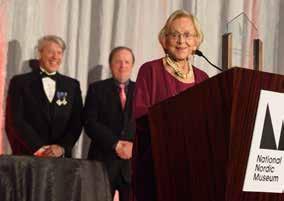
Elected to the Board of Trustees in 2006, Goertzen became one of two longest-serving Board Presidents in the Museum’s 45-year history. The first woman in the country to run a major teaching school hospital at the University of Washington Medical Center, Goertzen also served as President and CEO of Magee Women’s Hospital and Magee Women’s Research Institute in Pittsburgh.
With her extensive experience in executive leadership, fundraising, and capital projects, Goertzen joined the Museum’s Board at a critical time as the campaign for the new Museum ramped up. Her tireless work for nearly a decade led to the successful completion of the Museum’s $53 million capital campaign and the realization of the community’s long-time dream of a permanent home for the Museum.
The Northern Lights Auktion continues that dream today by providing funding for all aspects of the Museum’s operations.
Mark your calendar for our 38th Annual Auktion: May 11, 2024!
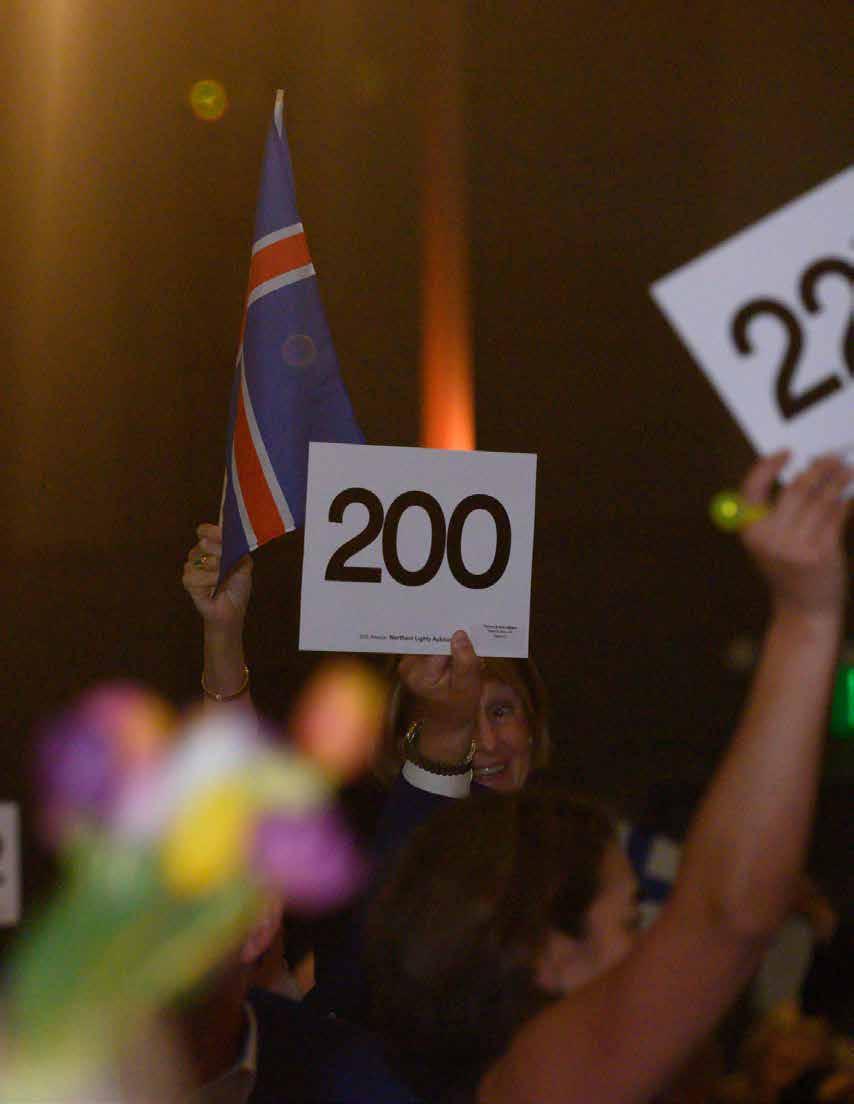 Photos by Nick Klein
Photos by Nick Klein
 By Tomas Colbengtson, Gunvor Guttorm, Dan Jåma, Britta Marakatt-Labba
By Tomas Colbengtson, Gunvor Guttorm, Dan Jåma, Britta Marakatt-Labba
INDIGENOUS PEOPLE AROUND THE WORLD EXISTED WELL BEFORE BORDERS OF NATION STATES WERE DRAWN. Borders that have not taken into consideration the indigenous peoples’ regions, the areas which hold our traditional places that have sustained us. Borders were drawn up according to the fells, valleys, lakes and rivers, and so forth. Meanwhile, people had always traveled across these regions, raised their families, lived in communities that socialized, expressed themselves through language and culture, led their lives. Many indigenous peoples have experienced how governments have annexed their regions for their own purposes which have not followed the will of the indigenous peoples. Despite this, the indigenous people of Arctic Highway have survived as a people, although they have had to struggle to maintain their culture.
Visitors to this traveling exhibition will be able to get a glimpse of what is happening in the world of Arctic art and duodji Sámi handicraft. The exhibition aims to pique the curiosity of indigenous peoples and create bridges between us, and also foster understanding and insight among the public at large.
Many indigenous regions are troubled by the exploitation of theirs lands and cultures. Has this exploitation reached its limit? Groups of indigenous people are, at times, pitted against each other, because we live in different nation states. In such cases, we may find ourselves fighting alongside authorities of the nation states against our own brothers and sisters who reside in other nation states. Nevertheless, we of the Arctic Highway still consider ourselves as one indigenous people. We agree that we want to work together and share our cultural experiences with each other, and that we will not let our national borders be an obstacle.
A cloud spread over the world—a cloud called “Covid 19”—and all borders were closed. Our idea for this exhibition was conceived at a time when all the world’s borders were closed. What is happening in the world? What is happening to the indigenous peoples? What happens when we must stop and reassess our way of living, both on a personal and interpersonal level? What has this time period done to the indigenous people? What is happening to our lands? Will there be further exploitation, and will we be forced into silence so that nation states can rebuild their economies? Or, will
our forefathers’ knowledge, which is still partially intact, become important in a new global reality? Have we, as individuals, learned something we wish to impart, to pass on? Now that the world is starting to open once more, have we perhaps learned to reclaim the knowledge and ways of our forefathers and mothers, seeing that there is more to our regions, appreciating them anew—on a personal level. Many of these thoughts are expressed through works shown in this exhibition.
The chosen theme—a borderless people—affords everyone an opportunity to reflect, in a broader perspective, on what it truly means to be borderless, both with a view to national borders and in a purely visual sense. What we see throughout the exhibition is that many of the representatives of Sámi culture featured here are engrossed with the experience of living in a landscape, both the beautiful natural one and the more cultural manifestation, the exploited landscape. Our point of departure is the events that have taken place over the past six months. However, we recognize that the exhibition’s theme can be interpreted very broadly.
The knowledge of the indigenous peoples—the silent and the silenced knowledge—must take its place on the global art map. Now, despite historical abuses and a culture of silence, this exhibition gives us the opportunity to tell our own story, through our own experiences, using our own forms of expression.
Originally published in the exhibition catalogue for Arctic Highways: Unbounded Indigenous People

Arctic Highways: 12 Indigenous Artists of the Circumpolar North, will be open from August 12–November 26, 2023.

Participating Sápmi artists are Matti Aikio, Tomas Colbengtson, Gunvor Guttorm, Marja Helander, Dan Jåma, Laila Susanne Kuhmunen, Britta Marakatta-Labba, Olof Marsja and Máret Ánne Sara. Participating from Canada are the artists Maureen Gruben and Meryl MacMaster. Joining from the USA is the artist Sonya Kelliher-Combs.

NATO IN 2023, the Finnish President visited the United States, including a stop at the National Nordic Museum in March.
President of Finland Sauli Niinistö addressed a joint session of the Washington State Legislature in Olympia on March 6. Marking the first time the Legislature has met in joint session since 1973 and the first time a foreign head of state has addressed it. His historic visit continued with a stop at the National Nordic Museum that evening to speak before a full hall of dignitaries, business leaders, policymakers, and community leaders.
In a fireside chat with Washington State Senator Marko Liias, himself of Finnish descent, President Niinistö discussed Finland's NATO membership, the European security situation, including Russia's aggression against Ukraine, as well as the partnership and economic relationship between Finland and the State of Washington.
The trip continued with a full day in in California on March 7 where President Niinistö attended several events. During a meeting with Gavin Newsom, Governor of California, and Eleni Kounalakis,
Lieutenant Governor of California, the main topics discussed were security and technology. Finland and California are forerunners in digital transition and climate policy. The President and the Governor considered it important to intensify cooperation to meet common challenges.
On March 9, President Niinistö met President Biden at the White House for the third time in just over a year. The initiative for the meeting came from the White House.
“We talked with President Biden about Finland’s and Sweden’s NATO membership”, President Niinistö told the Finnish media after the meeting. “The United States has supported us and continues to strongly support us in our membership process.”
During his time in Washington DC, President Niinistö met with Bob Menendez, Chairman of the Senate Committee on Foreign Relations for a discussion which included Ukraine, security, and NATO. A meeting with Kevin McCarthy, Speaker of the United States House of Representatives, focused on the economy and the bilateral relations between Finland and the United States.
President Niinistö also met with
Chairman Michael McCaul, United States National Security Advisor Jake Sullivan and Director of the Central Intelligence Agency (CIA) William Burns.
Also on Thursday, President Niinistö also spoke at an event organized by the Embassy of Finland in Washington D.C. on partnership in defense and emerging technologies.
The trip concluded on March 10 with visits to the U.S. Navy aircraft carrier USS Dwight D. Eisenhower and the NATO Allied Command Transformation (ACT) in Norfolk, Virginia, and additional discussions of NATO and transatlantic security cooperation. While in Virginia, he met with Secretary of the Navy Carlos del Toro and Vice Admiral Daniel Dwyer, Commander of NATO Joint Forces Command Norfolk. Additional discussions were held with General Philippe Lavigne, NATO Supreme Allied Commander Transformation (SACT). General Lavigne introduced the President to the activities of the Allied Command Transformation. With Governor of the State of Virginia Glenn Youngkin the topics of discussion ranged from global geopolitics to bilateral cooperation with Virginia.
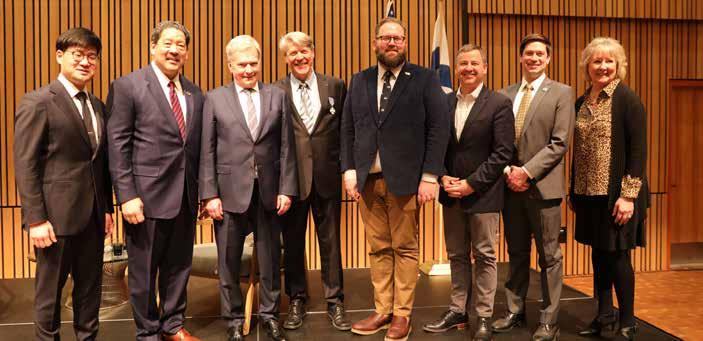
Throughout his visit to the United States, President Niinistö was accompanied by a business delegation with representatives from a wide range of industries.

President Niinistö’s fireside chat at the Museum was recorded. It can be seen on the Museum’s website in the News section, in My Nordic, and on the Museum’s YouTube channel. Further information about his trip was drawn from the article on www.presidentti.fi/en/news.
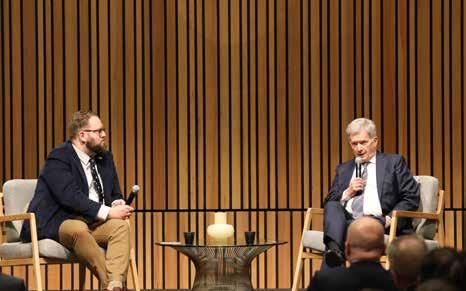
Opposite page, Port of Seattle Commissioner Sam Cho, Mayor of Seattle Bruce Harrell, President of Finland Sauli Niinisto, Executive Director/CEO Eric Nelson, State Senator
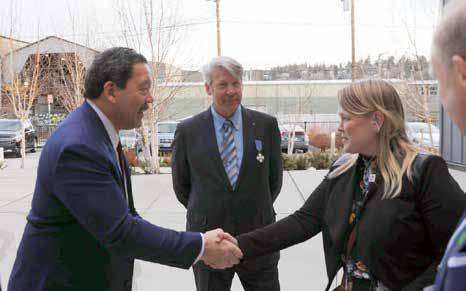
Marko Liias, King County Councilmember Rod Dembowski, City of Seattle Councilmember Dan Strauss, and Tacoma Port Commissioner Deanna Keller
This page: Images, clockwise from left: Fjord Hall filled with guests
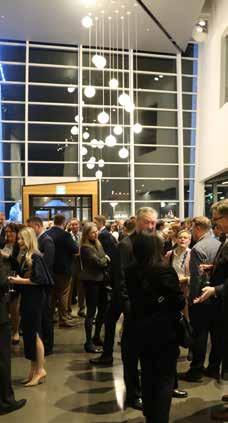
Honorary Consul Matti Suokko, President Finland Sauli Niinisto, Honorary Consul
Kristiina Hiukka
State Senator Marko Liias and President of Finland Sauli Niinisto on stage
Mayor of Seattle Bruce Harrell, Executive Director/CEO Eric Nelson, and Suvi JärveläHagström, Head of Cultural Affairs, Embassy of Finland, Washington DC

IT WAS A LATE FEBRUARY EVENING IN 2020, AND I WAS STANDING IN THE MARSHLANDS OF FRIESLAND, A NORTHERN PROVINCE IN THE NETHERLANDS. Above my head, hundreds of thousands of starlings were swirling, swooping, and diving in a dramatic fashion, blackening the sky. The sound of their wings reverberated through the air, creating wind patterns on the surface of the still water. The transfixing scene was the climax of three years I’d spent following European starlings along their migration routes across the continent. My only companion that night was a stranger who’d also stopped to watch the birds—an older woman who bore witness to the incredible spectacle for close to half an hour.

After the birds had settled into the large reed beds, she turned to me with tears in her eyes. “That was the most beautiful thing I have ever seen in my entire life,” she said. I had to agree with her.
After a 25-year international career spent photographing many of the world’s most famous musicians and actors such as Paul McCartney, Patti Smith, David Lynch, Pharrell Williams, Adele, Jack White, Björk, and Samuel L. Jackson, I recently returned to the landscape of my childhood in southern Denmark to photograph a visual phenomenon I first witnessed as a ten-yearold boy.

I began by photographing the large starling murmurations that take place in the northern stretches of the Wadden Sea, a coastal wetland environment— the world’s largest unbroken system of intertidal sand and mud flats, according to its UNESCO World Heritage listing— that stretches from the northern coasts of the Netherlands and Germany to the marshlands of southern Denmark.
Here, each spring and autumn, the skies come to life with the swirling displays of hundreds of thousands of starlings—an event known locally as “sort sol,” or “black sun”—as the birds pass through on their seasonal migrations. Later, I started following the birds along their migration paths and thus extended the reach of my photographic investigation to include England, Germany, the Netherlands, Ireland, Spain, and Italy. The past two winters I have spent in Rome, where millions of starlings stay during the winter months. It is well documented that starlings were present in great numbers in ancient Rome as they swarmed in massive flocks cascading and folding in awe-inspiring geometric patterns in the sky. Historically the birds hovering over Rome has played an important role in society, as Roman augurs, or diviners, scrutinized these patterns to attempt to decipher the moods of the gods. Divination was crucial for major decision-making as the augurs looked to the skies and “taking the auspices” to see if the gods would give, or withhold, their approval.
In 1890, a wealthy socialite and Shakespeare lover, Eugene Schieffelin released 60 imported starlings from England into New York City's Central Park. Schieffelin supposedly introduced starlings as part of a project to bring to the United States all the birds mentioned in the works of William Shakespeare. Schieffelin belonged to the American Acclimatization Society, a group that aimed to help exchange plants and animals from one part of the world to another. In 1970, there were 200 million starlings in the United States. Today the
numbers are dwindling with an estimated number of 85 million.
There is no single definitive explanation for why starlings murmurate, though most scientists theorize that the behavior helps protect the birds from predators (another possible explanation is that murmurations can help the starlings keep warm in the evening by recruiting larger roosts).
Moving in tandem as a single large entity both confuses predators and lowers the risk for each individual bird, a phenomenon called the “dilution effect.” Most of the dramatic performances I witnessed occurred when one or more falcons or hawks were attacking the starling flocks. What’s more difficult to explain, though, is how the birds are able to move in such proximity, with their movements so tightly coordinated. Studies have found that each starling responds to six or seven of its nearest neighbors, a number that seems to optimize the balance between the cohesion of the group and the effort of the individual.
Italian theoretical physicist Giorgio Parisi won the Nobel Prize 2021 for discovering the “interplay of disorder and fluctuations in physical systems from atomic to planetary.”
He states, “The murmuration can be better understood if we study similar systems with phase transition like crystal formation, avalanches, metal becoming magnetized, liquid turning to gases. In each of the above-mentioned system at a particular moment in time, the phase change of a single element affects the whole system within no time. The phenomenon is described as scale-free correlation. In such critical systems, size does not matter. If a single bird changes speed or direction, no matter how small it is, it affects the whole system. We can use this insight to better understand complex systems include things like climate ecosystems, financial systems, and global information networks.”
In creating this series of images, I was inspired by a number of other art forms, including classical landscape painting, calligraphy, and Japanese woodblock prints. I found a Japanese paper mill that produces handmade Washi paper made from juniper fibers. Once I started printing the images on that paper stock everything came together. The organic texture of the paper and the flocks of starlings became one.
I was also inspired by the birds themselves. When starlings move as a single unified organism and assert themselves against the sky, they create a strong visual expression, like that of a calligraphic brush stroke. Lines and shapes emerge within the swarm, bringing to life physical abstractions and calling to mind the patterns formed by interfering waves. The graphic and organic shapes of the starling murmurations range from meditative to highly dramatic as they perform a breath-taking ballet, one with life-and-death consequences. At times, the flock seems to possess the cohesive power of superfluids, changing shape in an endless flux. From geometric to organic, from solid to fluid, from material to ethereal, from reality to a dream: This is the moment I attempt to capture—a mere fragment of eternity.
Søren Solkær: Black Sun will be open from December 10, 2023–March 3, 2024.
 By Leslie Anne Anderson, Director of Collections, Exhibitions, and Programs
By Leslie Anne Anderson, Director of Collections, Exhibitions, and Programs
THE 5TH ANNUAL SÁMI FILM FESTIVAL, in partnership with Pacific Sámi Searvi in Seattle and Scandinavia House in New York City. This year's Festival introduced the new position of Guest Curator of Film. It is essential that the selected individual is a member of the Sámi filmmaking community. With this new approach to organization, the Museum seeks to better represent Sámi film through careful curation, which is its own form of storytelling, and authentic participation in the Festival’s organization. We invited award-winning Skolt Sámi director and co-founder of the production company Oktober, Katja Gauriloff, to serve as the inaugural guest curator. Katja’s connections with emerging and established Sámi filmmakers resulted in a thoughtful lineup that told both meta- and micronarratives of past and present life. Her work in creating the world’s first film shot in the Skolt Sámi language, spoken by approximately 300 people, demonstrates her forward-looking approach to the preservation of culture. At the Festival, I spoke with Katja about her directorial work, as well as that of her colleagues.
LA: Leslie Anne Anderson, Director of Collections, Exhibitions, and Programs, National Nordic Museum
KG: Katja Gauriloff, Filmmaker and Guest Curator

LA: What led you on the path to become a director?
KG: It’s a big question (laughs). I have no easy answer for that, but I think I was always interested in art when I was a child. I was painting, writing stories, recording stories. And then I found the camera. A photography camera. I took pictures and I did some music in a little student theater. I was into theater and many things (laughs). But then I found this camera. And I went to act in one movie. I was 21 years old and I went to do some acting and I was more into what the camera man was doing. That was the only interesting part in making that film. I wanted to see what the camera man was doing. Then I started to think that maybe I wanted to be a cinematographer. Then I applied
and went in and very fast after that, no, this camera thing is not enough. I want to tell stories. And I went back to this when I was a kid, telling stories in my head. And I changed to [the] directing and writing department in my school.
I think it is because I have storytelling in my blood. Because my great grandmother was a well-known Sámi storyteller. Of course, it was oral storytelling. Maybe I have to do what I’m doing, make films and tell my stories and tell our stories by making films.
The beginning was not so easy when I wanted to make my first documentary. I was still at school in 2005 and I had an idea and I wanted to have the finals for that but it wasn’t easy at that time because nobody really understood why we have to have Sámi films. It was really hard. But our broadcaster, broadcasting company Yle, there was one person who believed in me. And he said, “Ok, there is a grand, go and shoot something and show me what you have.” And I did that. And I got my first film done. In that time, all the filmers, they didn’t really understand why we need. And they even said, “All the reindeers, it’s not so media sexy”. I was like, “What?” (laughs) I’m not going to shoot reindeers. There is more. But nowadays,
after this 20 years, the world has changed, and Finland has changed. Now our films are more wanted and needed.
LA: They are indeed. You’ve talked about the storytellers in your family who have inspired you. Are there other storytellers and filmmakers today that are informing your work or that you’re really interested in following?
KG: Yes, of course I watch films and the film history. I think my eternal inspiration is my great grandmother and my people to tell stories. Because I know that Sámi people are one of the most researched people in the world. And there is a lot of recordings and even written stories they have recorded. So I can find a lot of that material from different archives. There are books, there are film materials. For the rest of my life, I can make films about those stories.
LA: Your latest film Je’vida is the first made in the Skolt Sámi language, and it explores Sámi identity and cultural assimilation. What prompted you to embark on this project?

KG: This was a dream for, I don’t know, 15 years. I’ve been dreaming about this film. I think when I was a kid my mother told me a lot of stories about her childhood and youth. She told me about her grandmother, of course, and grandfather. I think those stories were the inspiration for this. And my mother’s life has been an inspiration for making this film.
Also, because when I was a teenager I realized why I don’t speak my mother’s tongue. Why my mother never spoke to me, only in Finnish. It was a big sorrow. Then I realized later that it was not only in our family. It was in our generation. Lost. I started to look back on what has happened. I realized that there is this assimilation, forced assimilation, but in a quiet way. Yea, I wanted to talk about that in a film. I hope the film is poetic. Told in a poetic way and not very direct.
LA: Could you tell us a bit about producing this film and how it might have differed from others that you’ve made?
KG: We were writing with my writing partner for I think three years. And last year we had a shooting. But the most challenging thing was to find actors. Because we have a very small people and only 200-300 people speak our native language as a mother tongue. So I was always worried how I can find actors from that group of people. I started to make a little casting. I needed to find a girl, an eight-year-old girl for the main role. It was not so easy, but I found an amazing little girl that is actually my relative. I think most of the actors are my relatives. (Laughter) It’s the nepotism of course (laughter).
There was one role for the grandfather. Of course, I wanted to have an actor who is good with the camera. But also
I wanted to have the person that would be nice with a little girl. They’re good together. They have to play close relationship. I didn’t find anybody. Then I realize, my mother has one cousin. I didn’t know him so well.
But I called him and I asked, “Are you interested in acting in a movie?”
“No. Me? No, never”.
“Please, I don’t have anybody else”.
(Laughter). I was begging him, “don’t say no. Let me come over and we can talk about this”.
Then he was, “Ok, come over”.
I went there with my producer and we started to talk little by little about the role and the work and then he was, “Ok, maybe I can do this” (laughter). And he was great.
LA: Were there other actors that took some convincing?
KG: Well yes, the grandmother is also my relative. Actually, you will see her in the last movie today. ŠAAMŠI movie. She will be there in this handicraft mentor. I went to her, “I have something to tell you, but I can’t tell it on the phone (laughter). I have to come to see you.” And I went there and seat with the tea and we chat. This and that.
“Ok, what do you have to tell me? You have something on your mind”.
“Ok, I’m making this film and this is about this old woman who comes back to her home”.
And she was immediately, “You want me to be the old woman?” (Laughter)
“No, you’re the grandmother.”
“Ok. Of course, of course”.
So it was so obvious that she will be in the movie.
LA: You’ve opened the door to a new mode of expression for many and you’ve also been a mentor to emerging filmmakers. Would you like to talk about that?
KG: Yes, it’s my friend, Sunna. You will play the movie this afternoon [in the Sami Film Festival], Boso mu ruovttoluotta. She was making this really personal film about herself and asked me if I can help her with the process and I did my best to mentor. I, of course, want to help other film-
makers, upcoming filmmakers to do their best if I can.
LA: You have curated a selection that represents a range of genres, yet it highlights films by and about Sámi women. How did you approach creating the lineup for this year’s Sámi Film Festival?

KG: Yea, of course I picked the films that I like and they are very recent from last year, or the year before. And you haven’t had them before. Because most of the Sámi filmmakers are women. It’s really rare in film area because globally it’s very masculine. In Sápmi, we have a little different situation that most of the people, directors are women. So it was nice to watch these films and pick, because I think it was a good selection this year. Next year will be also very great. I already know it. I think we have this female power. Women talking about their stories. No other people would tell our stories but our women.
KG: You were earlier asking about storytellers that inspire me. Now I remember one important thing, Japanese 60’s horror movies (laughter). I want to do something else.
LA: What is it about those movies that inspire you?

KG: They are really different than western Hollywood films. I want to try to break up, and find something, and develop something that is closer to our traditions. As a filmmaker there is something linear we are working on but I want to break and find something cyclic as Sámi stories are. I have a lot of time now to start finding out what it can be and try something new. There is something in these Japanese films that is something else (laughs).
Transcribed from a recorded interview at the 5th Annual Sámi Film Festival (February 11, 2023) by Media Producer and Oral History Specialist Allie Cheroutes.
This year's SEA Nordic Film Festival moved to Ballard's famed Majestic Bay Theatre. The award-winning feature films, documentaries, and shorts celebrated diversity and showcased female directors, bringing the best of Nordic cinema to the neighborhood.

BLUSH: An Extraordinary Voyage (2022), Directed by Iiti Yli-Harja


Prejudice & Pride: Swedish Film Queer (2022), Directed by Eva Beling


Holy Spider (2022), Directed by Ali Abbasi
Gimme Some Truth: Nelly & Nadine (2022), Directed by Magnus Gertten
Power of the People (2022), Directed by Mervi Enqvist
So Damn Easy Going (2022), Directed by Christoffer Sandler
Sponsors:


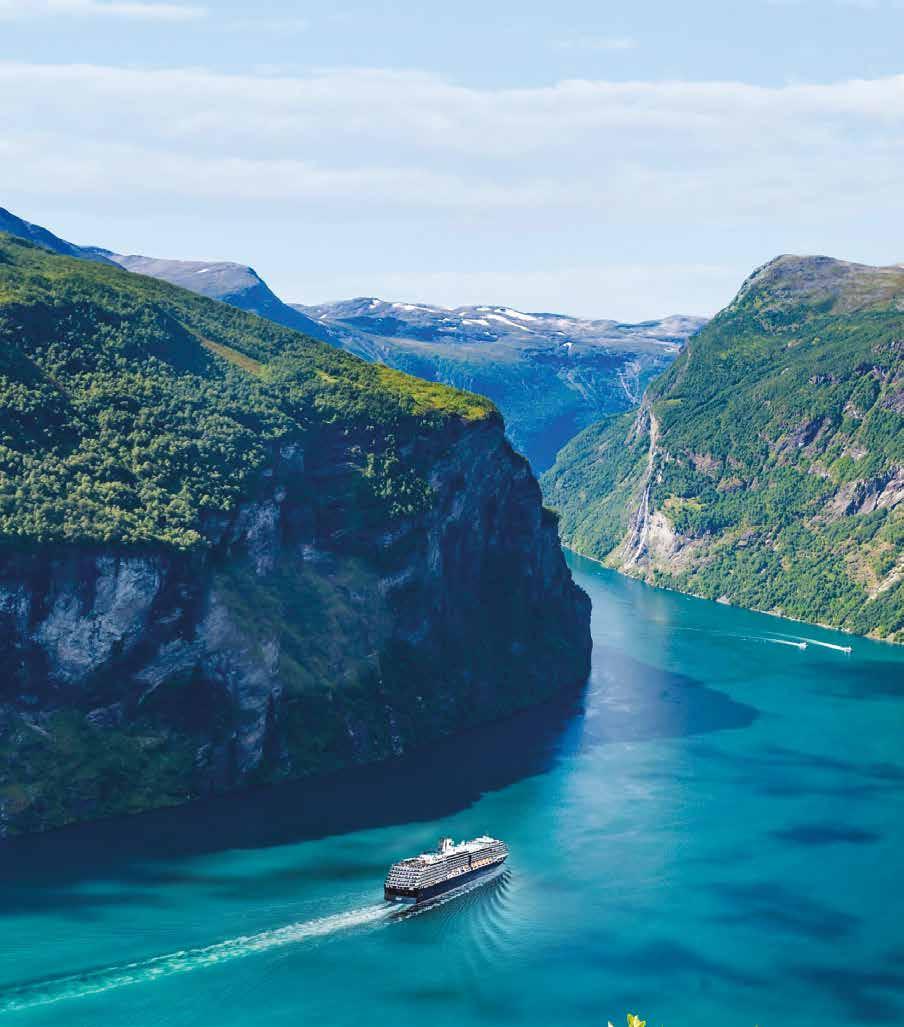
To achieve the required accreditation, Volta Trucks worked with the experts at ATEEL UK Ltd and ATEEL S.à r.l., the international Technical Service, and SNCH, The Société Nationale de Certification et d'Homologation, the Luxembourg approval authority who oversee approval for international UNECE and European regulations. These approval bodies oversaw the testing and reports to secure the certification of the Volta Zero. The vehicle underwent multiple systems and individual component testing on areas such as braking, steering, lighting, and glazing, along with the vehicle safety systems.
Co-founders Carl-Magnus Norden and Kjell Waloen began Volta Trucks began in Sweden in 2019. The company is focused primarily on operations across all major cities in Europe and the UK, and has accelerated the transition to all-electric trucks, reducing the effects of climate change and helping make cities safer, healthier and more sustainable for everyone.
Waloen, Co-Founder and Chief Manufacturing & Logistics Officer of Volta Trucks, will be a speaker at the Nordic Innovation Summit 2023. A former World Cup racer for the Norwegian Alpine Ski Team, Waloen has more than 26 years of experience in the automotive industry, starting with Ford Motor Company and later holding significant positions with Volvo. At Polestar, he was part of the leadership team that started the company and built the first Polestar plant in China. At Volta Truck, he co-developed the vehicle and set up manufacturing from scratch to start of production for sales in four years. The Nordic company Volta Trucks announced in March that significant milestone on its journey to production of the 16-ton all-electric Volta Zero vehicle.
The purpose-built delivery vehicle received European Whole Vehicle Type Approval (ECWVTA) certification allows Volta Trucks to produce and sell the all-electric Volta Zero in volume. It’s the process used to ensure that all vehicles meet the stringent and relevant environmental, safety and security standards.
The certification of the all-electric Volta Zero comes as the second-generation ‘Production Verification’ prototypes are soon to be delivered to customers across Europe as part of a pilot fleet of vehicles. These vehicles will be loaned to customers for extended periods of time, allowing fleet operators to fully understand how the all-electric medium duty truck will integrate into their operations.

The Volta Zero was designed to be electric from the outset. With no internal combustion engine, the operator of a Volta Zero sits in a central driving position at a much lower seat height than a conventional truck. This combination, plus a glass house-style cab design, gives the driver a wide 220-degrees of visibility, minimizing dangerous blind spots.
“Receiving the European Community Whole Vehicle Type Approval is a huge milestone for Volta Trucks, and our mission to make city center streets safer and more sustainable for all. We’ve developed a completely new vehicle from the ground up, and it’s a testament to our Engineering and Development teams that the Volta Zero has passed these stringent and demanding tests so quickly. We are now all set for the start of Series Production at our manufacturing facility in Steyr, Austria, to put trucks into the hands of our customers, and start the work of delivering on our mission,” said Essa Al-Saleh, Chief Executive Officer of Volta Trucks.

Gov. Jay Inslee of Washington State and other policymakers will be on hand to talk about the importance of trade and North American opportunities for Nordic companies. Áslaug Arna Sigurbjörnsdóttir, Icelandic Minister of Higher Education, Science and Innovation, is among the Nordic policymakers expected at the Summit.
Additionally, Dr. Erik Angner, Professor of Practical Philosophy, Stockholm University, will be drawing from his latest work, How Economics Can Save the World: Simple Solutions to Solve Our Biggest Problems (2023).
Organized by the National Nordic Museum, the Nordic Innovation Summit presented by the Washington State Department of Commerce has become a worldrenowned event where international organizations, political leaders, and academics share cutting-edge innovations.
In May 2023, the Summit will address a range of topics all centered on this year's theme of "Sustaining Sustainability" in a rapidly changing world. Among the renowned speakers already confirmed for the Summit are Juha Christensen, Chairman, Bang & Olufsen; Stephen Elop, Chief Executive Officer, Digital.ai; Henrik Henriksson, CEO, H2 Green Steel; Torunn Trongsvang, Founder and CEO, Up Norway; and Martine Kildeby, Head of Strategic Partnerships, BLOXHUB.
Chris Cooper, CEO of Neste US, will make the case that investing in sustainability is more relevant than ever. Additional CEOs speaking at the Summit include Pippa Boothman, CEO of Playfinity, Jakob Liedberg, Founder and CEO of Cinis Fertilizer, Frank Vang Jensen, CEO of Nordea, Einar Gustafsson, CEO of American Seafoods, Petra Hilleberg, President & CEO of Hilleberg the Tentmaker, and Freya Thorarinsdottir, Founder & CEO of GemmaQ.
While it is more important than ever to work towards sustainability and green innovation, these efforts are facing mounting challenges. In the US, sustainability as a business priority has created heated debate on the local and national level, while the Nordic countries have broad, long term political and popular support for ESG (environmental, social, and corporate governance) in business.
In response to these challenges, the 2023 Summit will bring together founders, corporate leaders, policymakers, and other innovators from both regions to showcase businesses and projects that demonstrate the need and opportunity to do well by doing good. This year’s Summit will have a greater emphasis on manufacturing and industry as part of the solution. Companies like Volta Trucks, X Shore, and American Seafoods will be represented, along with organizations like the Center of Sustainable Infrastructure.
The 2023 Nordic Innovation Summit takes place on May 10 and 11 at the National Nordic Museum. The Summit’s May 11 morning session will be streamed live from the Museum. Recorded sessions from 2023 will be available for viewing on My Nordic after the event ends.
More information can be found at nordicmuseum.org/innovation.
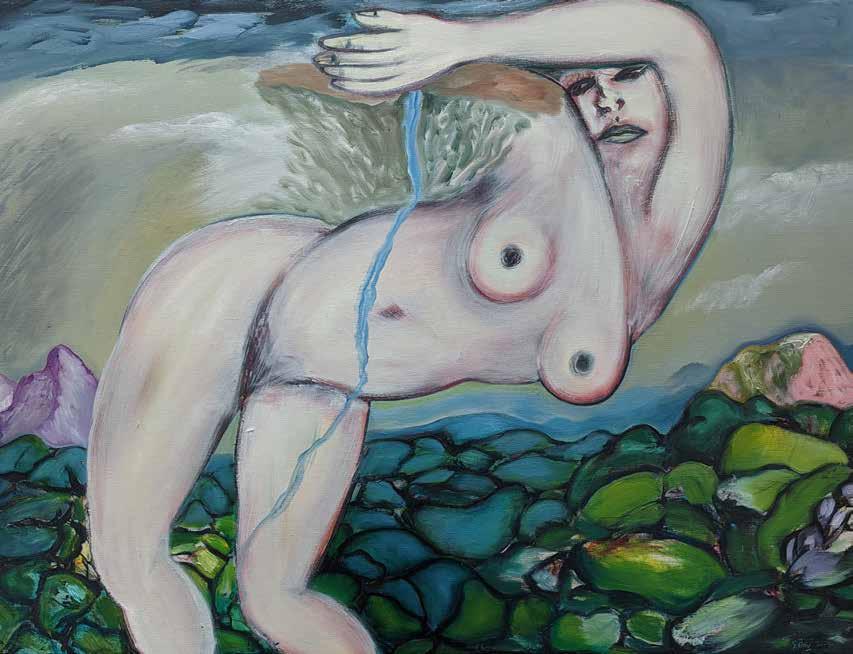 By Leslie Anne Anderson, Director of Collections, Exhibitions, and Programs, National Nordic Museum
By Leslie Anne Anderson, Director of Collections, Exhibitions, and Programs, National Nordic Museum
THE NATIONAL NORDIC MUSEUM’S EXHIBITION PROGRAM has featured authentic artwork on loan from national galleries in the Nordic countries—Denmark’s Statens Museum for Kunst in 2019 – 2020, Finland’s Ateneum Art Museum and Museum of Contemporary Art Kiasma in 2021, and Sweden’s National Museum in 2022. In all three examples, the Museum hosted the North American premiere of the exhibition. We also debuted and created important displays of cutting-edge contemporary Nordic art. Coincident with the expansion of our exhibition program, the Museum has acquired and commissioned works by significant Nordic artists both past and present as seen in these four pieces of art recently added to the Museum's permanent collection.
OPPOSITE: Gunnar Örn, Untitled, 1987 – 1991, Oil on canvas. Gift of Parks and Ginger Anderson.
This painting was purchased directly from the artist by Washington-based donors Parks and Ginger Anderson.
The work of Swedish-born, Norwegian artist Hans Heyerdahl (1857 – 1913) is now represented in the collection by a halflength nude. A canonical Norwegian Realist who worked alongside Christian Krohg (1852 – 1925), Edvard Munch (1863 – 1944), and Erik Werenskiold (1855 – 1938), Heyerdahl painted scenes of everyday life, landscapes, and portraits, some of which are represented in Norway’s Nasjonalmuseet. The painting shown here was created after the artist spent considerable time in Paris, near the end of his life, and it bears a relationship to the pastel palette of contemporaneous French artists.
ABOVE: Hans Heyerdahl, Untitled, 1908, Oil on canvas. Gift of Annichen Kassel.
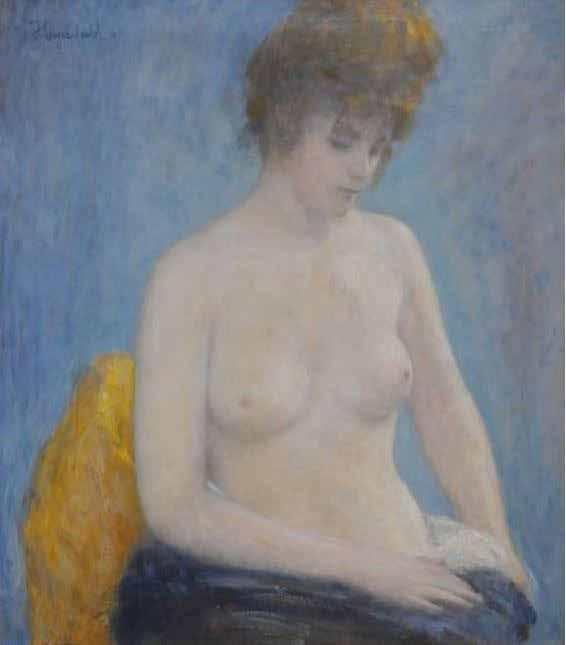
This painting appeared in a 2014 episode of PBS's Antiques Roadshow. Donated by Annichen Kassel of California, this painting remained in the family for generations.
The radical expression of self-taught Icelandic artist Gunnar Örn (1946 – 2008) contrasts with Heyerdahl’s subdued naturalism. Situated in nature, Örn’s nude is no figure study. The painting focuses on the primordial forces that shape the Icelandic landscape, symbolized in the distorted human form. In the 1980s, Örn experimented with bold colors and loose brushwork, and this painting dates to that period. He represented Iceland in the São Paulo Biennial in 1985 and the Venice Biennale in 1988.
In early 2023, the Museum commissioned Stina Folkebrant (b. 1968) to paint a mural on its campus. The mural memorializes the temporary exhibition Mygration and the over 500 reindeer who traveled by ship from Norway to North America, and then by rail across the continent from the East to the West Coast. In March 1898, the reindeer were placed temporarily at Seattle’s Woodland Park, before continuing their journey to Alaska. Folkebrant, who paints in grayscale, depicts two males fighting for a mate, who awaits the outcome on the periphery of the composition.




Stina Folkebrant, the 9th Mygration painting, Autumn Fight. Medium: acrylic spray paint, 2023.
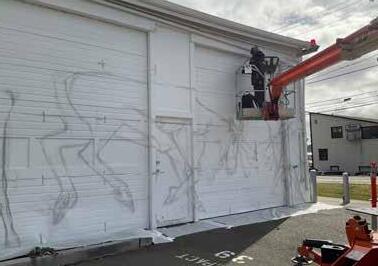
Encouraged to paint landscapes in art school, Sámi artist Tomas Colbengtson (b. 1957) eschewed the advice of his instructors. Instead, Colbengtson has explored the history and culture of Sámi people through his multimedia practice. In 2022, the Museum debuted the artist’s collaborative work with muralist Stina Folkebrant, Mygration, to a North American audience. The artists reflected on the arrival of Sámi reindeer herders in the 1890s at the invitation of the United States Government in the creation of their contemporary work. Among the pieces included in the exhibition were Colbengtson’s ceramics, which are printed with historic photographs of Sámi reindeer herders and their families from Nordic and North American archival collections. The Museum has purchased one of these works for its permanent collection.
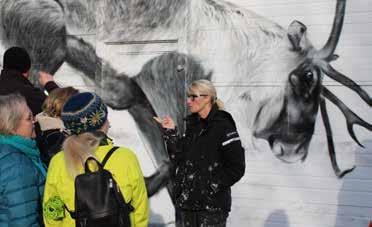
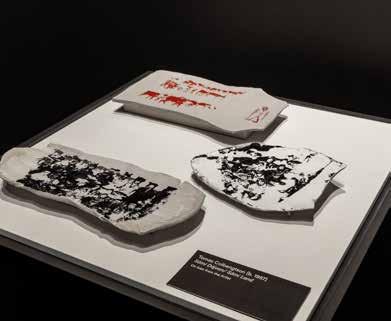

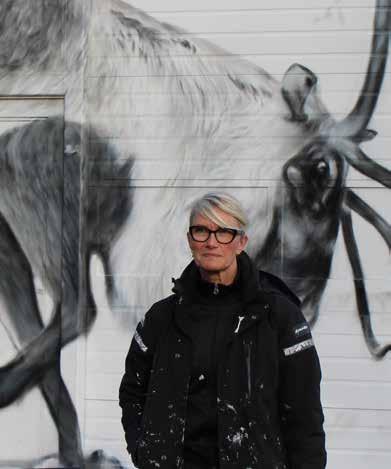 Tomas Colbengtson, Sámi Dájvan/Sámi Land from the exhibition Mygration.
Tomas Colbengtson, Sámi Dájvan/Sámi Land from the exhibition Mygration.

Jónsi: FLÓĐ
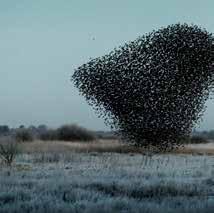
March 17–July 30, 2023
Barbro Osher Gallery
The Whale Child: The Illustrations

March 25–July 9, 2023
Fjord Hall Alcove
Steinnun Thórarinsdóttir: Wayfinders
July 15–November 5, 2023
Throughout Museum and Fjord Hall Alcove
Arctic Highways: 12 Indigenous Artists of the Circumpolar North
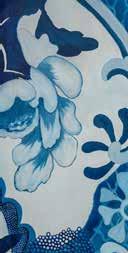
August 12–November 26, 2023
Barbro Osher Gallery
New to the Nordic: Selections from the Permanent Collection


November 11, 2023 through 2024
Fjord Hall Alcove
Søren Solkær: Black Sun
December 10, 2023–March 3, 2024
Barbro Osher Gallery
La Vaughn Belle
January 13–April 7, 2024
Barbro Osher Gallery
African Americans in the Nordics
March 23–July 21, 2024
Barbro Osher Gallery

Sad that you missed the First Lady of Iceland’s sold-out book talk at the Museum? Bummed that someone interrupted you in the middle of that papercutting class online? No worries! The National Nordic Museum’s rich and diverse collection of programming is now gathered at My Nordic. Members can log into this collection of online videos, connect with each other, and participate in upcoming programs all with one click! Just remember to use your primary Membership email the first time that you log in.
"On My Nordic, you can watch a President talking about preserving language in the digital age, a First Lady discussing gender equality, important contemporary artists providing insight into their process, leading experts in their field advancing persuasive theses and bringing new information to light,

and so much more,” said Leslie Anne Anderson, Director of Collections, Exhibitions, and Programs, upon the launch of this new feature that she helped to develop.
The My Nordic section of the website opened to Members in January 2023 and had more than 900 users by the end of the month. Plans are currently being made to allow non-members to access this platform as part of the ticket price of certain events.

Come by the Museum cafe and experience new treats, both sweet and savory, as well as fantastic coffee served up by our friends from Cardoon. Be sure to tell them that you are a Member and receive a discount.

Open Tuesday-Sunday, 10AM-5PM
Scan

The 2022 Julefest brought more than 7,000 people through the door in its first eight hours—and as many came back the next day! Everyone’s favorite outdoor Nordic Christmas Market hit several new records: most pre-event tickets sold for Julefest (over 5,000 by the day before opening), more outdoor vendors than 2021, more merchandise than 2021 (the glögg ran out again! but they promise extra in 2023), and, of course, thousands of aebleskiver whipped up by the volunteer crew.
Thank you to our 2022 Julefest sponsors: Icelandair, Peoples Bank, Town and Country Markets, Ballard Alliance, and The Seattle Times.

This Museum holiday event returns November 18 and 19, 2023. Watch the website for more details!
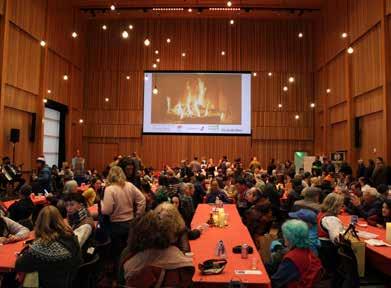

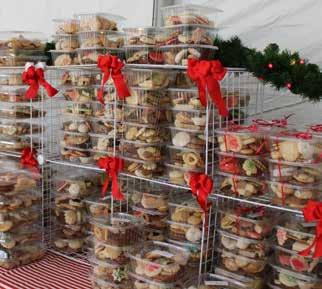


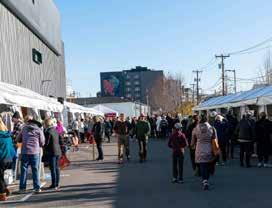



A long-standing tradition dating to the late 1800s, the Nordic people have elevated the warm and inviting Christmas tradition of special cookies for the holidays to a culinary delight.
Originally, once commercial ovens became readily available to the masses, people from the Nordic regions would invite their friends and family over to stay a few days and share the traditional cookies with their guests.
Designed to have a playful balance of generosity without being “too showy,” the baking provided a generous amount of festive hospitality while being relatively frugal.
Fast forward to the modern day where this tradition has continued across all Nordic countries as well as
within households that found their homes elsewhere, you can still guarantee the delightful smell of festive baking coming from the kitchen inviting you to bite into some powdery sweet Swedish Princess Gems or the robust nuttiness of Norwegian Kransekake Sticks. Though other traditions have woven into the present and future generations, the warm taste of Nordic home will always find its place.
So have yourself a little Scandinavian Christmas any time of the year by making some Nordic cookies of your own!
Following recipes contributed by the volunteer bakers of Goodies2Go unless otherwise noted.
A tiny Danish cookie traditionally served at Christmas flavored with spices, nuts, and pepper. Fun to make for kids and adults alike!
1 cup butter, room temperature
1 cup light or dark brown sugar
1 egg
1 cup almonds or hazelnuts
pulverized (prepared almond meal, not almond flour, works well here)
2 ½ cups all purpose flour
1 teaspoon baking powder
½ teaspoon baking soda
1 teaspoon freshly ground cardamom
½ teaspoon each cinnamon, ginger, allspice and nutmeg
¼ teaspoon each clove and finely ground black pepper
1 cup powdered sugar, sifted if necessary to remove lumps
• Preheat oven to 375°F and prepare two baking sheets by lining them with parchment. Or use an ungreased cookie sheets
• In a large mixing bowl, cream butter and brown sugar until light and fluffy. Add egg and mix well
• Add pulverized nuts and mix well
• In a separate bowl combine flour and spices
• Add to the butter mixture and mix until a stiff dough forms
• Shape the dough into a ball
• Cut off a portion of the dough at a time and roll with a hands-on work surface to make a “snake” about ½–thick. Use a scissors or knife to snip off ½–inch pieces of dough. Place on cookie sheet about ¾–inch apart
• Bake for about 8 minutes or until lightly browned. Cool on rack
Meanwhile, sift powdered sugar into a flat bowl
• While still slightly warm, toss the cookies in the powdered sugar.
• Knock off extra sugar
¾ cup shortening
1 cup sugar
1 egg
4 tbsp molasses
2 cups flour
2 teaspoons baking soda
½ teaspoon salt
1 teaspoon ginger
DIRECTIONS
1 teaspoon cinnamon
½ teaspoon cloves

Sharon’s notes on ingredients:
• Use dark molasses
• Use Bob’s All-Purpose white flour
• Add ½ cup diced crystallized candied ginger chips for a different texture
• Cream together shortening, sugar, egg, and molasses
• Sift all dry ingredients together
• Add to the creamed mixture and mix
• Make balls the size of walnuts or smaller
• Place on greased (or parchment paper) cookie sheet
• Flatten with glass dipped in sugar

• Bake at 350°F for 10–11 minutes
Sharon’s notes on instructions:
• Or use 2 teaspoons of the cookie scoop
• Makes about 3 dozen 2½–inch cookies
• For crisp cookies, bake until nearly all cookies have “fallen”
• For slightly chewy cookies, remove them from the oven before cookies have “fallen”
Ginger Snaps (Elise Olsson) From Tasty Traditions (Nordic Museum, out of print)Create a dramatic and memorable atmosphere for any event, large or small.
INGREDIENTS
1 cup butter at room temperature
1 cup granulated sugar
1 egg
• Preheat oven to 375°F
3 cups all-purpose flour
1 teaspoon baking powder
¾ cup dried currants
• With an electric mixer cream butter and sugar together until light and fluffy. About 3 minutes
• Add egg and mix well
• In a separate bowl, mix flour and baking powder
• Add flour mixture gradually to the butter mixture and mix until well blended
• BY HAND stir in the currants
• Using a small (about 1–inch) ice cream scoop, make small balls of dough. You can also roll the balls in your hand. If you do this, use a measuring spoon to scoop dough so that all of your cookies are the same size
• Place balls on parchment lined baking sheet about 2 inches apart. Flatten with a fork making deep grooves
• Bake until golden but not brown, about 5–8 minutes
• Remove to rack to cool
Einar’s Cookies
(Finland) From Tasty Traditions (Nordic Museum, out of print)
INGREDIENTS
1 cup room temperature butter
2/3 cup sugar
2 cups flour
• Cream the butter and sugar very well
1 cup finely ground nuts (filberts, almonds, or pecans)
1 teaspoon vanilla
• Add the rest of the ingredients and mix well
• Shape into long rolls about ½–inch in diameter
• Cut into 2 inches pieces and form into half-moon shapes. Or simply leave them in 2-inch logs
• Place on a parchment-lined cookie sheet. (1 inch–1½ inch apart)
• Bake at 325°F for 16–20 minutes
• Remove to cooling rack
• When cool, sprinkle powdered sugar on top
• Makes about 5 dozen cookies














The National Nordic Museum debuted a new space for youth and their caregivers in early 2023. Located in the Perspectives Gallery of Nordic Journeys, the Family Learning Alcove features a cozy reading nook and curated library. Planned educational and art-making activities encourage exploration of the values highlighted throughout Nordic Journeys. This gallery asks visitors to reflect on the Nordic values of openness, sustainability, connection to nature, and innovation through thoughtful questions posed on interactive kiosks, which encourage contemplation at the close of the Museum visit. The Family Learning Alcove offers a complementary experience for early learners. The familyfriendly space represents the final phase of a multi-year, pandemic-era plan to create meaningful and memorable
in-person and virtual learning experiences for the Museum’s youngest visitors. These include:
• In 2022, the Nordic Explorers Backpack program launched. Sponsored by Fjällräven and Krueger Sheet Metal, Nordic Explorers Backpacks are included with the price of admission and may be checked out at the front desk. Each backpack contains learning activities for children ages 3 to 8 and their adults to learn about 12,000 years of Nordic history together during their travel through Nordic Journeys.
• Expanded programming fuels creativity and fosters discovery of Nordic art, culture, and history. Led by guest educator Julie Lucas, weekend art-making
 By Leslie Anne Anderson, Director of Collections, Exhibitions, and Programs and Kate Dugdale, Education and Interpretation Specialist
By Leslie Anne Anderson, Director of Collections, Exhibitions, and Programs and Kate Dugdale, Education and Interpretation Specialist
classes guide students through expressionistic works of Norwegian painter and printmaker Edvard Munch in the summer. Six summer camps, three presented with Seattle Children’s Theatre, provide opportunities for children ages 4 to 11 to take the stage, unleash their inner thespian, or travel back in time to the Viking Age.

• One of the most successful strategies for youth, and specifically teen, engagement has been the virtual exhibition program. The Museum’s first virtual exhibition Experimental Selfies: Students Respond to Edvard Munch’s Photography featured the work of Advanced Placement 2-D Art and Design students in four local high schools. Of this assignment, one Garfield High School student commented: “having my work on display, not only in front of my class but also for other schools and viewers gave me a reason to really try and invest myself in the project.” With every exhibition, a curator-led tour introduces students to the exhibition and then their instructor guides them through the creation process, exploring the techniques, subject matter, and themes on display in the gallery. Since the launch of this program, the Museum and local students
have collaborated on four virtual exhibitions, available to view on the Museum’s website.


• Teachers are an integral part of our decision-making process and delivery of the Museum’s educational offerings. We solicit input from the Teacher Advisory Committee (TAC), which formed in 2021, and share our resources through a new page dedicated to School Programs on the Museum’s website and an Educator Open House held twice a year.
TAC members work with the Museum’s education team to shape the development of new educational materials and resources. In fall 2022, the TAC assisted in the creation of a new outreach trunk about Sámi history and culture. This trunk offers a hands-on learning experience of materials central to Sámi lifeways, as well as examples of craft by duodji artists, and language cards that familiarize students with Sámi-language vocabulary. Outreach trunks can be rented by K-12 educators and contain lesson plans to help guide the classroom experience. To get involved in the TAC and other educator programs at the Museum, please contact programs@nordicmuseum.org.



Around January 20 begins the old Nordic month Þorri. During the month Icelanders and people of Icelandic descent around the world gather for a þorrablót—a celebration of Iceland’s more peculiar culinary traditions. Dried cod, fermented shark, and boiled sheep’s heads, to name but a few dishes, might not be to everyone’s liking, but they are an important part of Icelandic history. University of Iceland
Professor Terry Gunnell explains that the þorrablót is not an ancient ritual, but a part of a nation searching for an identity.





“The modern þorrablót traces back to the mid 19th century, which was a time when the independence movement was taking shape,” Gunnell said. “At the time people were attempting to create a national identity that differentiated Icelanders from Danes. The food people would have at a þorrablót harkens back to Iceland’s golden age of the Vikings; the last time Iceland was an independent nation.”

Þorri begins during a time when not much happens. It is the coldest time of the year and Christmas is over. That also ties into the food which, as Gunnell explains, is “basically leftovers of what people had during Christmas.” Some of the milder tasting foods served at a þorrablót are enjoyed yearround. Hangikjöt (hung meat) is smoked and boiled lamb that is often served with mashed turnips at festive occasions. Harðfiskur is wind dried fish jerky that people enjoy as a
snack and is often served with butter, and the liver sausage lifrarpylsa goes along great with the blood pudding blóðmör for dinner.
You would be hard pressed, however, to find some of the more exotic dishes in the local supermarket. The best known is the fermented shark or hákarl. World renowned chef Anthony Bourdain once described it as "the single worst, most disgusting, and terrible tasting thing" he had ever had. It has a pungent odor and bitter taste. However, many Icelanders swear that it smells worse than it tastes.






